BIGGER






 Richard Mitchell, President, Cinema Technology Community
Richard Mitchell, President, Cinema Technology Community









 Richard Mitchell, President, Cinema Technology Community
Richard Mitchell, President, Cinema Technology Community


Welcome to the December 2022 edition of Cinema Technology
Magazine, the first edition produced by Cinema Technology Community (CTC) as the new custodians of the publication. I say custodians rather than owners because we at CTC believe the magazine truly belongs to the industry. And, like those custodians who have gone before us, we will endeavour to build on the incredible legacy left by Jim Slater and Bob Cavanagh, and latterly by the team at Motion Picture Solutions (led by Ian Thomas) to create an impartial platform for the industry to learn about trends, technologies and business-related subjects.
That we inherit such an incredible publication is also testament to a cast of literally hundreds of people over the years that have given up their time
willingly, to create accessible and compelling content that has kept the magazine at the very summit of technology publications for our industry. And that CTC as an organisation is even in a position to do this is down to the incredible hard work and determination of the entire CTC team that have so passionately supported the global industry, particularly over the past five years. To each and every one of you – a sincere thank you!
So, the custodian may have changed, but your publication remains as you’d fully expect it to be, packed with fascinating and relevant content. I’d like to pay special tribute to the team that make the magazine possible in Helen Budge, Peter Knight and Dean Chillmaid. Their commitment over the past few months to support both the publication and the CTC team during the transition
process has been nothing short of incredible, we are truly honoured to have such an amazing team producing your magazine and we’re delighted they’re continuing their journey with the publication.
Whilst the December edition is now in your hands, know that we’re already working on exciting concepts for the future, identifying ways in which the magazine might further support learning and education across the industry - we’re always open to ideas so please feel free to reach out to us!
For now, it only remains for me to wish you, your colleagues and families a happy, healthy and prosperous 2023.
It’s time for Mariah Carey’s classic, “All I Want for Christmas”, to be played on repeat
(side note: I read she’s made $72 million to date from that song alone - that’s the gig to get!) and for some chestnuts to do some roasting.
So, for this December 2022 edition, we wanted to do a larger-than-life edition to see off the year in style, and focus on premium LARGE formats (also known by the alternative moniker, premium luxury formats). From fully immersive experiences, to 3D sound, to the accompanying technology, and our regular overview of the industry, we’ve a whole host of treats in store. For those of you whose brains are tech-sponges, to those of you, like me, for whom the technology of cinema is a whole new world, there’s something for everyone.
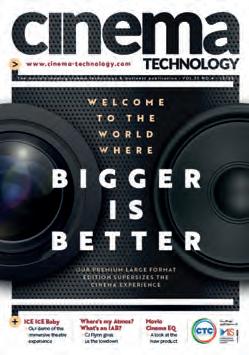
Whether you want to learn more about the different elements of an ICE(Theaters)-cold immersive experience or if you’re confused about why an IAB label will soon be replacing a [Dolby] Atmos label on (relevant) DCPs; grab a mince pie, pour some eggnog and dive right in (... does anyone actually drink eggnog?!)

But it’s also important for us to state from the outset that, although we’ve covered some PLF companies and formats, the content in this edition is far from an exhaustive list of “worthy” PLF products and services. There are many others that deserve equal focusIMAX, CinemaNext’s Sphera, Qube, to name a few. If you want to discuss being featured editorially in an upcoming magazine edition, then drop Peter Knight, our Commissioning Editor, a line on commissioning.editor@cinematechnology.com and we’d be delighted
to include you (where relevant).
It just remains for me to say a massive thank you to MPS for their support and guardianship of the magazine over the last few years. And a huge thanks to CTC for taking us on to the magazine's next phase - we’re excited for the next chapter!
A PLF-sized festive greeting to you all, with all the trimmings. And a big thanks to those who have contributed content, and to those who advertise with us - you (literally) keep us going.
Helen Budge, Managing Editor, Cinema Technology MagazineChristie demonstrates the CINITY system at CineAsia 2022.
Stuart Dickinson is named as Vista's new CEO, as Kimbal Riley announces his retirement.
David Hancock looks to the tech of the (near) future for cinemas.
Is automation the future for the tech behind the PLF experience?
Peter Knight explores an ICE Theater auditorium experience and all it has to offer.
The spotlight's on WTW-Scott Cinemas in south west England.
Read all about Letchworth Garden City Heritage's tech upgrade.
CJ Flynn explains why an Atmos DCP label will soon just say "IAB".

Comscore's Lucy Jones talks box office numbers for Q4 2022.
DTS' Loren Nielsen talks BIG sound and how it all started with Steven Spielberg.
Movio's new product, EQ Cinema, gets a test drive in our review of the new platform.
An in-depth look at how to restore your Series 1 & 2 projectors.
ICTA gives a round-up of 2022 and looks forward to the start of the new year. CT Q&A
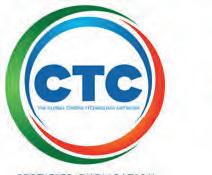
Movio's Sarah Lewthwaite looks back on her career and talks being a CEO in the cinema industry.
Cinema Technology Community (CTC) 124 City Road London EC1V 2NX
E: info@cinema-technology.com
MANAGING EDITOR: HELEN BUDGE
E: helen.budge@cinema-technology.com
ART DIRECTOR: DEAN CHILLMAID
E: dean.chillmaid@cinema-technology.com
COMMISSIONING EDITOR: PETER KNIGHT
E: peter.knight@cinema-technology.com
ADVERTISING: ADVERTISING TEAM
E: magazine.advertising@cinema-technology. com
Cinema Technology is mailed to IMIS Members. For subscription details and to read the magazine online, visit www.cinematechnology.com or email peter. knight@cinema-technology.com



These special demonstrations served to showcase the full capabilities of the CINITY Cinema System – a creative blending of 4K, 3D, high brightness, high frame rate, high dynamic range, and wide color gamut display capabilities, all paired with immersive sound. It improves the overall sound quality, and yields clearer images, brighter colors, and smoother motion to greatly improve the quality of cinema screenings. Christie provides high performance digital projection technology and services to CINITY.
Brian Claypool, Executive Vice President, Cinema, Christie, said, “We are delighted to have been able to conduct demonstrations of CINITY at CineAsia to promote this innovative and exhilarating movie-going experience. This is an affirmation of our strong partnership with CINITY, as well as our commitment to develop state-of-the-art technologies which continue to push the boundaries of theatrical presentation unlike any other in the industry. CINITY can enhance the overall cinematic experience and immerse audiences into every detail of the presentation.”
Inside the iconic BFI
IMAX ON Friday 11 November, the iconic BFI IMAX cinema reopened its doors to film fans following an ambitious refurbishment to create a completely immersive cinema experience. Wide-ranging enhancements include a new 4K IMAX with laser projection system, booming 12-channel sound technology and a brand new 65 foot IMAX screen –still reigning supreme as the nation’s biggest – all combining to keep the iconic Waterloo destination a must for movie lovers. This follows the BFI resuming the day-today running and programming of the landmark venue in July 2022.
Since launching 23 years ago in 1999, BFI IMAX has become one of the most successful IMAX cinemas in the world, welcoming an average of 300,000 visitors each year and playing host to some of the world’s biggest film premieres including “Eternals”, “Mission Impossible: Fallout”, “Inception”, “The Batman” and “X-Men: Apocalypse”.
The cinema giant has also introduced IMAX with Laser, designed exclusively for IMAX screens. The impressive upgrade will offer audiences both a premium technical and first-class customer experience.

FRONT of house workers play a crucial role in welcoming audiences and representing their venue to the public. The Independent Cinema Office’s new Front of House Workers Online Learning Course (bit.ly/3ikMJnt) provides staff in customer-facing roles with essential training to help them feel confident and safe in their work, understand their rights and welcome all audience members.
Drawing on the experience of industry experts, and intended to be used alongside in-house training provided by venues, this online course covers topics such as why front of house work matters, how to deal with difficult customers, welcoming diverse and disabled audiences and much more. The course is available as an institutional licence for organisations, at a reduced cost to individuals, or free to job seekers.
ARHT Media Inc. has announced that Thailand’s largest operator of movie theatres, Major Cineplex, has purchased ARHT’s Capsule hologram display technology in a move that is set to revolutionise the cinemagoing experience. Major Cineplex becomes the first cinema operator in the world to purchase the technology, with the announcement also marking the first sale of Capsule in the wider APAC region. This builds on the successful roll out of the hologram display system across North America and Europe throughout 2022. The announcement follows ARHT Media’s recent reporting of record Q3 revenues of $2.02M vs $1.05M in Q3 2021, an increase of 92%, showcasing the continued growth of the hologram technology sector.

In another agreement, ARHT has also
announced the installation of 10 Capsule holographic displays at market leading Indian cinema operator, PVR’s movie theatres. The agreement is expected to result in four locations being installed in Q4, 2022, and six additional locations in Q1, 2023.
Capsule is a plug-and-play, fully interactive 4K display system, enabling the merging of the physical world with the metaverse like never before. The technology has attracted great interest across the cinema sector following its unveiling at CinemaCon Las Vegas in April 2022, and the purchase of

Capsule will now enable Major Cineplex to deliver unique audience experiences, blending the real world and the metaverse in cinema and at special events.
Audiences will be able to meet and greet life-sized 3D holograms in real time, enabling talent to be beamed live to the screen from anywhere in the world. The Capsule technology also provides fully interactive functionality including motion sensors, touch screen and two-way cameras, providing immersive ways to gamify the lobby experience.

ARTS Alliance Media (AAM) announced the official opening of its United States-based subsidiary company, AAM US Incorporated (AAM Inc.), to support their ever-growing network of exhibitors and cinema integrators across the Americas.
The inception of AAM Inc. will facilitate comprehensive technical and commercial support to new and existing customers, and create a pathway to secure continued growth in the region, progressing AAM’s
international expansion strategy.
In a linked move, AAM has confirmed that their international customer base will now receive 24/7 technical support to maintain effective, fault-free operations and complete peace of mind. Now serving exhibitors from three continents, after opening AAM US Incorporated, customers from around the globe can access round the clock support, receiving first-class customer service and knowledge from years of industry experience.
All entries should be submitted by 2pm on Monday 9th January.
Arts Alliance Media (AAM) has announced the launch of Screenlighter, a brand new theatre management system (TMS), designed exclusively for small and independent cinemas.
With fast operational speed, effective content management functionality, and a bright and effortless user interface, Screenlighter compacts the proficiency of Screenwriter, AAM’s flagship TMS, into a dashboard that solely meets the operational requirements of independent and one-to-four screen cinemas.
Available from 2023, Screenlighter will enable cinemas to evolve from manual operations to centrally managing their screens, content, and KDMs from one location, from playlist creation and on-screen content control, to reporting and real-time site monitoring.

UNIQUE X has announced a resale partnership with Digima Srl, the Italian cinema integrator.
Based in Piemonte, Digima Srl will offer Unique X’s RosettaBridge TMS, RosettaNet CMS and BaseKey KDM services to the Italian exhibitor market.
As a major deployment partner of Unique X, Digima has already completed the rollout and training of the Rosetta suite of products to one of Italy’s
largest cinema chains. This provides Digima with considerable experience in not only installing RosettaBridge TMS but also providing local language training and configuration of the product within location.

Deployed with an Italian language interface, RosettaBridge TMS has developed integrations with Italian territory POS systems to create a fully automated operational workflow from schedule to screen.
SCREENING Room Map - the guide to private hire venues by Pocket Films - is celebrating its 20th anniversary. Launched in London with a mission to create a resource dedicated to promoting industry screening rooms, Screening Room Map has helped to promote the concept of private hires and to raise awareness of under-the-radar screens. The guide has expanded to an annual mixedmedia guide encompassing web, print and social media.
The publisher, Tony Franks, commented, “The best part of the development was my time spent in Soho, knocking on doors and asking managers if they would like to be featured in the guide. I’ve met a great bunch of people through publishing it, all very supportive.”
The future of the guide includes a new pocket edition for early 2023, new digital off-shoots, growth in the NYC and Los Angeles versions and a new worldwide expansion.
UNIQUE X has announced REEL Cinemas as the newest exhibitor that will be offering Book The Cinema (BTC) to its UK customers. BTC is an online service that gives consumers the opportunity to book private cinema events, choosing from a huge selection of movies including the latest blockbusters and many of the greatest classics.
Perfect for a variety of events from birthday parties to corporate bookings, Book The Cinema also allows consumers to create a personalised message that will appear on the big screen before their movie starts. This message can include images and videos, or a written message created by the consumer. Customers can pre-order food and beverages for their private event on the platform.
Book The Cinema is from Unique X, and utilises their suite of cinema automation and content delivery solutions.
HARMAN Professional Solutions has introduced the JBL PRX900 Series of loudspeakers and subwoofers, which features advanced acoustics, comprehensive DSP, power performance and complete BLE control via the JBL Pro Connect app. The line, which includes three powered two-way loudspeakers and two powered subwoofers, is built from the ground up to leverage JBL’s most advanced acoustic innovations.
SHENZHEN Timewaying Co. Ltd and Arts Alliance Media have launched the new DCI-certified 20-metre 4K HeyLED cinema screen, becoming the world’s largest digital LED cinema screen on the market.
Presenting a giant leap in cinematic LED displays, the HeyLED 20m cinema screen combines pure colour, true black, and a high contrast ratio with patented high pixel fill rate technology to enable a visual experience never seen before in exhibition. With high brightness up to 300 nits, 30,000:1 contrast ratio, 16-bit grayscale, and DCI-P3 wide colour gamut, the HeyLED 20m screen is of the highest specification, stronger colour, realism, and depth.

While HDR ready, HeyLED technology uses an active ‘black screen’ instead of a passively reflected ‘white screen’, which is the basis of its high contrast.
By delivering immersive, neverseen-before images and creating a clear point of difference in the rapidly growing PLF segment, the commercial proposition for exhibitors is truly positive. HeyLED not only enables closer front row viewing via high pixel fill rate optics, but increased back row seating from the removal of the project room, meaning higher admissions per screening. The brand’s status as the world’s largest PLF will also attract a larger pool of movie-goers, dictating increased ticket pricing to generate amplified box office revenue.
As official resellers of the immersive HeyLED brand, AAM will deliver the new 20m screen to exhibitors across Asia, Europe, and all of the Americas, transforming the in-theatre consumer experience while expanding their product portfolio.
Christie has launched the newest product in their UVC disinfection lineup. CounterAct UR10 commercial UVC disinfection products are the first to use both UVCLED and far-UVC light for enhanced airborne and surface disinfection. Upper room UVC-LED disinfects air as it circulates in the upper portion of the room, and Care222 light – the first farUVC technology with a patented optical filter to block potentially harmful wavelengths – continuously inactivates surface pathogens around people.
A state-of-the-art multiplex cinema with eight halls that can accommodate up to 400 visitors has been built in Chur, Graubünden, Switzerland, including an IMAX hall and a restaurant with a roof terrace. The major project celebrated its opening on October 27 this year. The original start of construction in 2018 had to be postponed by two years due to objections from residents, which even went as far as the Federal Supreme Court, but also due to COVID-19. In total, the costs for the large-scale project by the Swisscom subsidiary, Blue Cinema, amount to over 40 million Swiss francs.

CINIONIC, the leader in laserpowered cinema solutions, and Cinépolis, Mexico’s largest cinema company, have announced over 2,600 screens moving to laser projection. The deal brings laser projection by Cinionic to a significant portion of the global chain’s nearly 6,700 screens, delivering efficiency and up to 70% energy savings for Cinépolis - and an elevated viewing experience for their audiences.
The ambitious project brings laser projection to more of Cinépolis’ top locations following a rapid rollout to 1,300 screens with Cinionic earlier in 2022. The rollout, expected to continue later this year, will result in laser in more than 2,600 screens delivering an enhanced and laserpowered big-screen experience for millions of moviegoers for many years to come. Cinionic’s Latin America team is overseeing the extensive project.
The Totah Theater, New Mexico, has been fully renovated
SEVERTSON Screens (severtsonscreens.com) has announced that integrator CES+ has installed a 28ft. x 15.2ft. Severtson Giant Electric projection screen as part of its recently completed renovation of the historic Totah Theater in Farmington, New Mexico.

“Our Giant Electric projection screen is the ideal choice for Totah’s auditorium since it can be lowered and retracted at the push of a button,
opening up the stage space for other performances and opportunities when not in use,” said Aaron White, Home Theater & Pro AV sales lead at Severtson Corp.
As part of the renovation, CES+ also installed a laser projection Barco Series 4, Dolby IMS-3000 server with a CP950 sound processor and a 16-channel DMA16302 amplifier, and a JBL 7.1 passive audio system including speakers, surrounds, and subwoofers.


THE British Film Institute (BFI), the UK’s leading organisation for the moving image and the owner of the world’s largest film and television archive, has installed Christie's Real|Laser illumination technology in its main screening room, NFT1, at its flagship venue BFI Southbank. Following a trial period at the BFI
London Film Festival, a new CP4420RGB pure laser projector is now delivering incredibly colourful and detailed true-to-life images, combined with an excellent low cost of ownership and operational lifetime, thanks to the onboard Christie CineLife+ electronics and RealLaser illumination technology.
Flexound Augmented Audio has opened in 10 of United Cinema’s auditoriums in Odaiba, Japan, in advance of “Avatar: The Way of Water”. Flexound has been in close collaboration with the Japanese company on multiple cinema projects in Japan, including Flexound Pulse cinema sound, the world’s first fully loudspeaker-free cinema concept.
The technology is integrated into Premium Milano seats by Ferco Seating.
VISTA Group has announced the appointment of Stuart Dickinson as Vista Group’s new Chief Executive Officer with effect from Tuesday 11 April, 2023. Dickinson will succeed the role from Kimbal Riley, who is retiring after five years as Chief Executive Officer and nearly a decade at Vista Group overall. Dickinson joins Vista Group as an accomplished leader with more than 25 years’ experience in the technology sector, most recently as New Zealand Country Manager of NYSE-listed DXC Technology.
Dickinson commented: “I am excited to assume the role as Vista Group’s CEO and the opportunity to lead a
talented global team. Vista Group is an extraordinary New Zealand business that has made its mark on the global stage.”
Riley joined Vista Group in 2013 as Chief Operating Officer, before becoming Vista Cinema Chief Executive in 2015, and then assuming the Group CEO role in 2018.
Riley said: “It has been a privilege, and the highlight of my career, to lead Vista Group for the last five years and to work with so many talented people across our businesses globally. I’m confident that I leave the company with a strong team and a terrific future in Stuart’s capable hands.”
inema’s relationship with digital technology has not always been a harmonious one. Until cinema exhibition was pushed into digitisation from 2005, technology developments had mostly been of the analogue variety, and incremental, rather than abrupt. This was changed by the digital transition, and new technology in cinema is now a usual area of a cinema exhibitor’s life. However, non-cinema technologies have taken the world to places most of us couldn’t imagine we’d go. The arrival of the metaverse into the public consciousness underlines that technology is shaping human behaviour and leisure choices. And cinemas will need to become engaged
“
I’m trying to free your mind, Neo. But I can only show you the door. You’re the one that has to walk through it.”David Hancock,
Chief Analyst, Media &Entertainment, Omdia
with a range of consumer and professional tech that can bring them closer to audiences, and their sources of content. The opportunities are out there - if the mind is open.
Cinema has often been seen as the most immersive form of movie watching, underlining its tagline as “the cinema experience”, and, in more recent years, this immersion has been underpinned by technology. The release of the first “Avatar” reminds us how technology can create a jaw-dropping movie event. But some movies, since released, also serve to underline that technology usage for the sake of it is no guarantee of success. Used unwisely, a tech-driven film can lack purpose and audiences can’t connect with them. “Avatar: The Way of Water” juggles high frame rates, HDR, 4K and 3D with the need for a commercial success and brings immersion to the fore once again. It is interesting to note that the film is not promoting the HFR element of the film, using it merely as a filming technique when suitable (for example, in motion scenes) and not as a marketing hook. It’s the story, stupid.
It is also true that cinema is no longer the standout in image quality. Production quality for streamers and broadcasters is high, and VR/AR production has introduced a new dimension in which to create content. Video games are regularly created in high frame rate (HFR), or often variable frame rate (VFR). Cinemas need to grasp the technology mantle back, and immersive experience, as a core strength of cinemas, is the way to capture it.
More broadly, consumer technologies are also becoming
more relevant to cinemas. Mobile and web-ticketing has taken off in many countries following the pandemic and this lays the base for the next generation of the internet. Web3 is moving into the wider public consciousness, and the metaverse is beginning to be defined. The interaction possible in Web3 creates a major opportunity for the film industry to engage with its customers, such as using VR/AR. But it also creates an opportunity for audiences (the same customers) to invest in, and even distribute the type of content that interests them. The Disney Accelerator scheme is focused on Web3 companies in 2022 and the studio has set up a team to explore next-gen storytelling. Recent senior hires point to this strategy gaining ground internally. So far, forays have been limited to the more passive digital collectibles (in the form of NFTs) but the leadership accepts that this needs to become more immersive and engaging. In fact, Disney, Paramount and Warner Bros. have all experimented with NFTs in 2022. Disney’s Music Emporium is their next Web3 platform.
Smaller producers, distributors (and exhibitors) have most to gain from early adoption of Web3. The Film3 Collective is aiming to establish the foundations of this new industry approach, using blockchain-based solutions to help those who want to start their Web3 journey. And specialist tech companies will also drive the industry in this direction. Audiences, often overlooked in the discussions around whether or not to make a film, will begin to have more control over what they want to watch. Crowdfunding and use of NFTs (either the film as an NFT, selling NFTs to
fund a film or even selling merchandise following production) will allow a wider and more decentralised spread of rights holders.
And the metaverse (whatever it ends up looking like) is not only for others to venture into. Bringing cinema into the metaverse will also exploit its immersive strength. Korean cinema and tech group CGV opened the industry’s first virtual cinema in February 2022, Zepeto CGV World. The virtual cinema enables engagement with audiences in their home, while keeping them in the cinema-going world. Future strategies, centred around Web3, will include becoming part of the financial makeup of content that interests them, through NFTs and crowdfunding, giving exhibitors more control over their programming. And this was a weakness that exhibitors keenly felt as studios withheld content when the pandemic hit the world.
The metaverse promises immersion but is also the next way to tell stories, both core concepts of cinema’s success. Cinemas can be a force for change by becoming a space for new payment, marketing, and storytelling innovation, by creating their own engaging virtual worlds - but also by sourcing and investing in content. Metaverse cinemas will form part of the new marketing and distribution landscape and cinemas need to be in the game. Distributors and studios can build virtual universes for fans, outside of the immediate
confines of the movie, even meshing gaming and music with the movie IP, as a way to interact with audiences and provide a value-add. This will satisfy superfans in a way that current marketing strategies and loyalty schemes can’t.
Production is also moving into the virtual world, with virtual production now a reality for producers and directors. Virtual studios are cheaper and more efficient than a traditional studio. Virtual production takes the green–screen concept several stages further, combining a studio setting with lifelike location shooting. Producers can work through 30-50% more script pages in a day (“The Mandalorian”), eliminate reshoots, work on issues on the production and avoid the vagaries of weather. Crucially, virtual production is also a cleaner method as the world begins the battle to prevent terminal damage from climate change. The world’s first carbon neutral film, using global locations in one virtual studio, was shot for COP26 by the UK’s Garden Studios. The film emitted one tonne of carbon, which was offset (although that is not a long-term solution), compared with 120 tonnes if the film had travelled to all locations that were used in the film.
The arrival of consumer technologies into the cinema’s sphere of activity opens up a whole new world of possibility. Cinemas are the first - and principal - direct point of audience contact for films and they can be the main vehicle for engaging with customers right through the customer journey, from web search to screen and way beyond. This is an opportunity for cinemas to become the vanguard of new tech. Take a deep breath and walk through the open door.
“The opportunities are out there - if the mind is open.”
You probably know everything about Premium Large Format (PLF) by now; how comfortable the seats are, the stunning image and sound quality, experiences enhanced with premium services like private gateways, bars, restaurants and in-seat eateries. But do you know about the technology that not only sits behind it but keeps it working at the level movie-goers expect?

Let’s discover the technical challenges that PLF systems are facing daily and how these systems are maintained at the highest levels. When operating at their best, PLF systems offer movie-goers an amazing immersive experience, combining size and scale with incredible stories.
Over the past two decades there has been enormous growth in the PLF sector through the likes of IMAX, Dolby Cinema, ScreenX, 4DX and a host of exhibitor own-brand premium experiences, providing evidence that movie-goers recognize the value of PLFs. In fact in 2019, Harkness Screens commissioned research in the USA (through National CineMedia’s Ask The Audience panel) which highlighted that over 60% of movie-goers associate premium cinema with premium brands. And when questioned about which elements of the experience signify “premium”, 75% suggested

picture quality was the most important factor, closely followed by comfort, audio quality and then screen size. That association between picture quality and premium experience is indeed valid. PLF theaters in today’s cinemas are technological marvels, providing stunning image quality, and projecting upwards of 108 Nits (31fL) in 2D projection on 15m+ screens around the world. These projectors from the likes of Christie, Barco and NEC enable experiences at scale to be delivered through the latest laser technologies, particularly RGB. But often where screens are a significant size it is not possible with a single projection system to maintain these light levels over the life of the cinema auditorium (without a correctly specified gain screen).
Often large-sized premium format systems need to deploy dual projection technology providing more than 60,000 lumens to hit these exceptional levels of brightness and maintain them throughout the life of the projector. This is especially applicable to RGB laser projectors where creating sufficient headroom in power levels is essential.
Whilst dual projectors are often a requirement for largescale PLFs, such projection setups do require significantly more management and interaction from busy technical managers than a single projection setup. The main pain points caused by dual projection setups include dual
(Clockwise from top left:) Taking a screen reading; two NEC digital projectors running onscreen tests; measuring luminance levels; an onscreen test pattern for system configuration and confirmation

a
operates;
alignment, light balancing between projectors, colour drift, flat/scope lens alignment, projector focus, and keystone. So, to ensure that these problems are eliminated and the specifications of these high-end theaters are met at all times, exhibitors around the world are increasingly turning to automation to drive efficiency and help them manage these presentation and calibration challenges.
Whilst there are several handheld systems, meters, and manual tools to check the consistency of these metrics, they require an on-site technician or regular visits from engineers to identify and correct presentation issues. And there is always potential for differing results from visit to visit depending on various factors including the consistency of the engineer (is it the same person each time?) or the calibration of their equipment. Having a pre-installed automated monitoring tool allows system management tasks to be carried out automatically and on a consistent schedule in a consistent way, ensuring that it is comparable each time. This means that presentation quality is maintained, genuine faults or issues are identified faster, and often the requirement for onsite visits is dramatically reduced. By deploying an automated tool, exhibitors are able to maintain on-screen excellence and also quickly realise a return on investment through the deployment of such “always on” technology - and with substantially fewer disappointed customers.
Without network operation centre (NOC) integration, the tools are only as reliable as the person running the data up the chain. Whether this is a visual check or a manual reading from a spectrometer, the data needs to be relayed manually, and there’s always a risk that the data can be corrupted or mismanaged. When using a modern calibration system, it is important to know how your monitoring services are alerted when there is a problem. SNMP traps with NOC monitoring, after running daily checks, can ensure the right personnel are alerted as soon as something is determined to be out of specification. Other cinema monitoring solutions include custom integrations with monitoring and TMS systems such
Several automation products exist to manage presentation excellence and whilst dual projection systems are a primary driver for the demand of these, exhibitors with single projection setups, where quality matters, often also deploy automation systems for precisely the same reason.
Calibration systems that help keep these projection systems operational and aligned include Qalif Ultimate and Dual, Christie Duo and Mystique, and other proprietary systems from the likes of IMAX and CGS. The quality and features of these systems vary with the technology and algorithms developed by the respective companies. With these systems, integration with the projector, playback server, automation systems, and NOC are key features that must be considered beyond the quality of the result of calibration. Leading devices such as the Qalif Ultimate can guarantee dual calibration alignment down to 1.0 pixel on the zoom and 0.1 pixel on both the X and Y alignment with projectoron-projector alignment or using saved references for repeated on-screen consistency. It must also be considered to do this for both flat and scope projection aspect ratios, as scaling and cropping in a premium experience is highly frowned upon. Additional systems to improve alignments include Christie’s Mystique and custom IMAX systems. These products can map on-screen projections and move pixels at the chip level to provide a single image with limited blur due to pixel misalignment.
Other metrics that may be noticed in the theatre by patrons, and that need to be routinely monitored, include projector focus, light uniformity on a single projector and between projectors, colour shift on projector output and even audio channel output for Dolby Atmos systems.

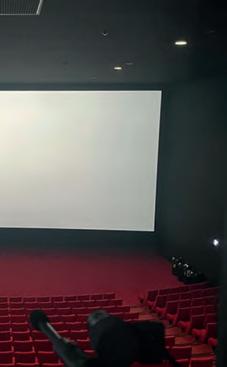
as CES Cielo+, GDC TMS, Unique X, CineXpert etc.
There are many theatres with PLFs and proprietary premium formats that use these, or custom-designed, calibration systems to ensure premium quality. As a leader in the PLF space, Dolby Cinema uses state-of-the-art technology throughout their cinemas and they manage that ecosystem with Qalif Ultimate. PLF pioneers, IMAX, developed and integrated a custom-designed alignment and audio calibration system into their auditoria.


Absolutely not! Automation systems have the potential to become the norm for exhibitors around the world. When you
consider the financial cost, time involved and the environmental impact of sending an engineer to cinema sites to carry out regular health checks, deploying an automation tool makes perfect sense.
When you consider the complexity of projection systems and how they’re evolving, seemingly every day, it’s likely most, if not all, auditoria will need monitoring systems in the future. Products like Qalif Optimizer or USL LSS-100 are already installed in many cinemas around the world, performing calibrations daily or weekly to ensure these cinemas are kept to the highest standards to ensure patrons return for more cinema adventures. And, after all, that’s what it’s all about - maintaining the magic of cinema.

What do you get if you take the best in cinema 4K RGB laser projection, add Dolby Atmos audio, sprinkle it with luxury VIP reclining seats, add some LED panels along each side of the auditorium, and put in carefully-selected lighting effects in the ceiling? And just to finish it off, a unique entrance into the screen? Why, you get an ICE Theater Auditorium!
Owned by CGR Cinemas in France, ICE Theaters is a PLF (premium large format) that is rapidly growing across the globe, with 50 ICE Theaters at the time of writing, across four countries (France, Spain, Saudi Arabia and the USA), with one opening shortly in India, and Estonia in 2023.
Back in 2017, CGR Cinemas Group (CGR) and global lighting leader, Philips Lighting, announced a collaboration to develop the Philips LightVibes concept, to deliver a unique immersive movie experience through connected light. It was an exclusive partnership to develop and distribute LightVibes, a breakthrough visual immersion concept for movie theaters themselves.
CGR introduced LightVibes on December 14, 2016, in Toulouse-Blagnac, France, as a key component of their ICEby-CGR premium Immersive Cinema Experience Theater concept. And feedback from general audience and cinema industry partners was consistently positive.
Since then CGR has gone on to package the technology and the overall experience into its own successful brand, blending the concept with their existing cinema expertise to produce a unique immersive premium format.

Peter Knight goes in search of the new immersive cinema experience that has proven popular in France and is beginning to seed itself across the world.

ICE Theaters was created by France’s second largest exhibitor, CGR Cinemas, owning over 700 screens.
There are 50 ICE Theaters globally: in the USA, Saudi Arabia, France and Spain; more ICE Theaters are scheduled to open later this year in India, and Estonia in 2023.
ICE Theaters works closely with all major Hollywood Studios for moviegoers to experience all the biggest blockbusters. They will now also be working with Bollywood Studios, and with Bollywood post-production, to release all major titles in the ICE format across the Indian territory.
The goal was to give birth to a brand-new innovative experience meant to captivate the most demanding moviegoers.
Over 120 blockbusters have been released in the ICE format, including “Top Gun: Maverick”, “Spider-Man: No Way Home”, “The Batman”, and “No Time To Die”.
The ICE experience is deliberately different from all other PLF experiences, while, like many PLFs, it still utilises additional hardware both in the projection room and the auditoriums. It’s made up of several technological and experiential factors detailed below.
The immediate first significant difference is the immersive corridor entranceway to the auditorium, designed to let the audience know that they are about to enter another world. The corridor uses the same LED panels (also used in the main auditorium) to create a “visual atmosphere” that is connected to the movie about to be watched.
Inside the auditorium, there is the traditional main cinema screen, but along each side of the screening room, there are a number of low-resolution LED screens. And in the ceiling, predominantly towards the rear of the auditorium, are LED stage lights - again, two big differences to any other PLF set up.

4K RGB laser projection is at the heart of the viewing experience. The technology of the digital projector is based on nine lasers (three laser beams per primary RGB colour) and these produce a brightness of 60,000 lumens, providing a spectacular contrast level and cutting-edge image quality.
The rooms all have Dolby Atmos audio that is configured for the maximum ear experience - with over 50 speakers
and 30 amplifiers meaning that no matter where you are sitting in the VIP reclining deluxe seats you will experience a comfortable movie with great sound. And here you have plenty of space to move about, with up to 1.8m gaps between the curved rows.
The idea behind ICE Theaters is to create an immersive experience without detracting from the main picture, and without having to create vast amounts of additional movie material specifically for the LED panels. Instead, these panels show images that are the same colour and style as those on the main screen, meaning they may differ from one side of the room to the other. But these immersive panels are used to give a greater sense of speed and direction of movement within the movie (where appropriate) and to enlarge the vastness of a landscape or reinforce the impact of an explosion. The design and purpose of the LED panels is to reflect the peripheral vision of the human eye, maintaining the immersion of the audience in the movie.
In addition to the side LED panels, there are overhead moving lights that allow for a number of effects, again designed to enhance the experience and to immerse the audience in the film.
The system is flexible enough that if there is not a movie showing in the ICE format then the side screens are switched off. They disappear into the walls and are designed to be acoustically neutral.
Top: the main ICE Theater auditorium (OCINE Granollers)
Middle: A film mash-up display (OCINE Granollers)

In order to make the ICE content work correctly, there is a separate ICE server located in the projection room that has the specific playback script on it. This script tells the side panels and overhead lights in the auditorium what to show and play. It is all synchronised via timecode to the main DCP of the film, so it automatically plays at the right time.

In terms of the business model, often there can be as many in number as there are different types of PLF options, but the ICE Theaters auditorium works on a straight purchase, with a five-year service. It is expected that the cost is recouped in less than five years and generates additional revenue from day one when compared to a traditional auditorium.
“I was looking for an experience that would sublimate the image, that would give the film an additional visual power, and that would allow the viewer to dive into the heart of the movie.

ICE Theaters is an addition of elements of technological perfection: the absolute comfort of reclining seats, Dolby Atmos sound system, the latest generation of laser projection, and the ultimate experience with the ICE Immersive technology. ICE Theaters is a compendium of excellence. All studies show that moviegoers are looking for a premium cinematic experience. ICE Theaters is a flamboyant response to this demand, an accelerator of attendance and seat-occupancy rate, a booster of boxoffice revenues, a vector of increase in average ticket price, and a concept that creates consumer satisfaction.”
Bouyssy, CEO, CGR Cinemas - ICE Theaters
Like any special viewing experience, ICE Theaters’ success is dependent on the available content, especially when it requires something additional to be done to the original feature, as with ScreenX or D-Box. But with over 120+ titles available - many of them from the big studios, including the biggest movie titles of the year - the ICE format is proving to be successful. The number of titles that are available in the format means that there is the opportunity for nearly one screening a fortnight and these screenings include some of the biggest titles that are being released in the mainstream.
One of the main differences between ICE Theaters and other immersive experiences is that 100% of the movie is in the ICE format, so there is no coming “in and out” which can happen with other formats and is off-putting and confusing.
In 2022 so far, there have been 25 titles released in the format, including a rerelease of “Avatar”, “Top Gun: Maverick”, and “Elvis”.
“Avatar: The Way of Water”, will be released in December.
Content is provided by the studios in advance and the ICE team then work with it to create the experience in their own facility, known as “the bunker”, before it is approved by the studios and sent off to the cinemas.
In a relatively short time, ICE Theaters has become the leading immersive and high-end theater screen format in France. When compared to the average occupancy in a similar capacity standard auditorium, ICE records numbers twice as high and similarly sees double the box office when compared to the national average market share of CGR’s cinemas.
During CineEurope 2022 I got the opportunity to visit an auditorium at the OCINE Granollers cinema, ICE Theaters’ first immersive screen in Barcelona, Spain, where I saw a demonstration of the ICE system for myself. And it did not disappoint.
The first thing you encounter is the entrance corridor which makes it clear that you are about to experience something exciting and, literally, unusual. The lighting effects create a warm welcome, beyond the initial signage for the entrance. You then enter the auditorium that continues with the same lighting effects, duplicating them across all of the LED panels that are now lining the sides of the auditorium. It’s a pleasure to discover the seats are very comfortable to sit - or even lie - in, given how far they actually recline.

Probably one of the most noticeable things about ICE Theaters compared to other PLF experiences is that it was not housed in the largest of the auditoriums in the cinema. However, it is a perfect size to provide the intended, optimal experience - the audience can see the whole auditorium without having to move their heads. This is where previous versions of this technological experience have failed, by using the largest auditoriums where the full width of the screen could not be seen, and experienced to the full. ICE needs the audience to be able to take in the full width in their peripheral vision for it to be effective. But not having to use the largest auditorium is also an advantage in terms of flexibility. And the whole concept is designed to help reinstate the cinema as being a spectacular location again, different from anywhere else.
The demonstration included a variety of different content from adverts to trailers to feature film extracts, including “Top Gun: Maverick” and “Doctor Strange in the Multiverse of Madness”. Most of the content had the desired effect, keeping the audience immersed but there were a few scenes that showed that it doesn’t work, aesthetically, for all types of content. Overall, however, it was a success, with the additions of the overhead lighting adding the perfect little extra touch. And it’s another option that can’t be currently reproduced in the home - something that cinemas should always be trying to do. Like ScreenX, 4DX and others, opinions can be split as to whether it is worth experiencing and worth the ticket uplift. This question is - what, exactly, do you want from your cinema trip? But we’re so lucky to have the choice! Whether the format appeals or not will probably also depend on whether you’re able to concentrate on more than one thing at a time, with lots of visual information coming at you from different angles - or whether you prefer one focus. Personally, my brain likes both so I love the ICE experience. CGR has used their long-established knowledge and experience to develop it into an extraordinary PLF alternative.
As a lover of technology and cinema, I’m excited by the ICE team’s work and I look forward to seeing (and experiencing) what they do next.
In 2017, WTW Cinemas and Scott Cinemas merged to become WTW-Scott Cinemas. Sandie Caffelle talks to Director, Mark Williams, about the merger and how the future’s looking for the company, in...

CT: When were WTW and Scott Cinemas formed?
WTW Cinemas was formed in 1945 with the purchase of The Capitol Theatre in St Austell. The founding members were the father and grandfather of current owner, David Williams, who joined the business in 1966. David’s sons, Robert and Mark (myself), joined the company in 2000 and 2002, respectively.
Scott Cinemas was founded in the 1960s by Charles Scott, who at the time was the manager of the Alexandra Cinema in Newton Abbot [Devon, England], with Peter Hoare becoming the owner in the 1980s. At the time Peter became the owner there were four (mostly loss-making at the time!) cinemas in Bridgwater, Dartmouth, Lyme Regis and Newton Abbot.
CT: What were your separate achievements prior to the merger?
Since forming in 1945, WTW Cinemas has evolved to its current operation of four cinemas, all in central and eastern Cornwall. The cinemas are in Newquay, St. Austell, Truro and Wadebridge. St. Austell and Newquay are purpose built, new-build cinemas that opened in 2008 and 2011.
Scott Cinemas has grown to operate seven cinemas from Barnstaple in North Devon, up to East Grinstead in West Sussex. October 2022 saw the company open our biggest cinema with a seven-screen complex in Bridgwater Northgate, with the other cinemas being located in Barnstaple, Bristol (Henleaze), East Grinstead, Exmouth, Newton Abbot and Sidmouth.
For both companies, the cinemas are primarily in smaller towns and cities and form a key part of the local
high streets and town centres, with the cinemas ranging from one to seven screens (now including Bridgwater Northgate.
There have been many awards presented to both companies with The Plaza Truro winning RAAM Independent Cinema of The Year in 2006, the Central Barnstaple winning the same award in 2008 and White River Cinema in St Austell repeating that success in 2011. The technical team at The Plaza Truro was presented with the Team of the Year Award in 2013 at the Dolby Headquarters. David Williams was awarded an MBE for services to Regional Cinema in 2013, with Peter Hoare being given an Exhibition Achievement Award at the 2018 Screen Awards. Peter was awarded the British Empire Medal for services to cinema in The Queen’s Birthday Honours List in 2020.
CT: Why did you decide to amalgamate the two companies and when did this happen?
Scott Cinemas owner, Peter Hoare, approached the directors of WTW in 2015 regarding the possible purchase of his company. In 2017, a first sale of shares in Scott Cinemas to WTW took place, with WTW Cinemas becoming the majority shareholder in 2019. The companies shared many of the same suppliers and had a great deal of similarities, with David Williams and Peter Hoare having a long-standing friendship on the back of both companies’ growth and success over many years.
CT: What have you achieved together so far, as a single company?
In the last five years, there has been extensive refurbishment of the cinemas at Exmouth and Wadebridge, alongside smaller works at other cinemas and all the planning for the new seven-screen cinema in Bridgwater Northgate which opened in October this year. We have worked closely with Eomac for new wall decoration and acoustic panelling during the refurbishments, and also installed new Ferco seats at Bristol, Exmouth and Truro. Bell Theatre Services installed laser projection in screen one at Barnstaple and the same was done at the Bristol site before the cinema reopened in July 2020 following the first lockdown. A complete new sound system and all-new laser projection was installed at Sidmouth at the end of the first lockdown period.
The new cinema at Northgate, Bridgwater will be the
Find us here
WTW-Scott Cinemas,UK
The two companies together have 11 sites, Scott Cinemas operates seven, from Barnstaple in North Devon up to East Grinstead in West Sussex.
WTW Cinemas has four sites in central and eastern Cornwall.

Top: The Plaza, Truro, Cornwall
first new build to open across both companies since 2011 and it features two Atmos screens, as well as laser projection in five of the seven auditoriums. The cinema will have all new seats installed from Ferco, with two VIP screens including a 12-seat private hire screen.

CT: What are your plans for the future?
The most immediate plan was to open and establish the new seven-screen cinema in Bridgwater, a project in partnership with Sedgemoor District Council. Discussions are currently ongoing regarding a new cinema in Newton Abbot as part of Teignbridge District Council’s plans to redevelop the town centre.
The Bridgwater foyer
All existing cinemas will be refurbished as necessary,
with the Central at Barnstaple earmarked for the most extensive works, including the possible addition of extra screens. There will also be a programme of sound and projection upgrades. Laser projection has been installed in screens in Barnstaple, Bristol and Sidmouth, and this will be extended to other sites over the coming months and years.
CT: How about diversification? Will you step into noncinema activities and if so, which areas would these be in? The new cinema at Bridgwater will feature a café area and an increased food and beverage offering as the cinema will be open throughout the day, so that will have an added focus in addition to cinema-going. This will be our first venture into a wider food offering so I’m sure there will be lots to learn along the way!
In our more recent new builds, we have seen venues used for conferencing and events on several occasions, and now that those types of events are happening more widely, post-pandemic, we’d like to be able to expand this and offer a wider range of uses. We’ve seen things like gaming parties become very popular in some locations, so broadening the use and function of our cinemas will be important, going forward.
One aspect we have seen since the pandemic is the decline in neighbouring restaurant operators, which has had quite an impact on the nighttime economies of several of the towns in which we operate. It might be that in the future we look to work more closely with restaurant operators for a mutually beneficial relationship and to
increase the vibrancy of the areas in which we work, particularly in the evenings.
CT: What are your views on the future of the industry as a whole? Is there anything that WTW-Scott would like to see change or happen?
The cinema industry has brought us so much over many years and it’s one we have loved being a small part of. We’ve been very fortunate to have developed so many good and close working relationships over many years and we’ve loved being part of an industry that has proved resilient throughout all the challenges it has faced, particularly in the last two-and-a-half years. Certainly, we’re incredibly appreciative of the hard work and dedication of our cinema teams over such a long time, there have been so many people who have stayed loyal and helped us along the way. The last couple of years have seen challenges that we could not possibly have envisaged. But we’re very grateful to still be here and look forward to what the future holds with a great deal of optimism.



The beautiful art deco venue, designed by Bennett and Bidwell and built by Howard Hurst, became a popular venue for occasional rallies, speeches and live music after its opening. And the site itself featured in the 2013 movie “The World’s End”, starring Simon Pegg and Nick Frost, with the cinema doubling as “The Mermaid”, a pub at the heart of the story.
Like so many of its peers, the building has undergone both major and minor refurbishments since its opening, reflecting the cultural evolution and demands of this local, vibrant and diverse community. These changes have seen the site morph from the original single-screen site opened more than 85 years ago, into a modern fourscreen cinema that has retained its art deco features. At the heart of the building is a large multi-purpose 400+ seat auditorium complete with stage, and designed to host cinema screenings (via a large electric roller screen), as well as live theatrical productionsincluding musicals, plays and
stand-up comedy. The three additional smaller screens showcase first-run movie content, as well as event cinema, including ballet andopera. And the venue is owned by Letchworth Garden City Heritage Foundation; a charitable foundation with clear objectives to improve the lifestyle and wellbeing of Letchworth residents, as well as enhancing recreation and leisure opportunities for all.
Arguably one of the more significant changes occurred over 11 years ago when the site moved from film to digital, converting its four existing 35mm film projectors to Kinoton Series 2 projectors, at the same time as installing 3D technology into two of its four screens. This was a move
that enabled the cinema to retain its status as a cultural hub at the centre of the local community.

Over the past 10 years the cinema has undertaken a number of minor upgrades including the installation of a new 10-metre wide, 3D-enabled, roller screen to the cinema’s main auditorium - and in the summer of 2020, the deployment of four new Dolby IMS3000 servers.

In 2021, the Heritage Foundation recognised an increasingly pressing need to replace the projection equipment in each auditorium, “We’d identified a number of areas of concern regarding our Kinoton projectors which made them a long-term operational liability. Given the age of the units, obtaining spare parts was
becoming a significant challenge, something that was only exacerbated by Covid, and something we recognised would get worse over time,” explained Jason Valentine, Venues Manager for the Heritage Foundation. “As well, the operational and consumable costs of running ageing xenon-based projectors meant that they were becoming more and more uneconomical to run even before the global energy crisis we’re now experiencing. And our other major concern was long term compatibility with future technology. So we looked to the market to identify options that would help us address these issues”, Valentine added.
Having met with every major projection technology company during CineEurope 2021, Valentine quickly identified the large number of different options available to the cinema but felt compelled to seek further impartial guidance, “As an organisation, we’re not ostensibly cinema operators, in fact, the cinema forms just a small - although important - part of our operations to support the local community. That means our knowledge and expertise, particularly from a technology standpoint, is somewhat limited. With such a wide range of options available, we needed independent guidance to help us firstly understand the best-fit solution for the cinema, and secondly, to ensure
that we were driving maximum value from the investment, something which is essential as a charitable organisation,” Valentine said.
So they turned to the Cinema Technology Community (CTC) to provide impartial guidance, focusing on three specific areas. Firstly, an assessment of the pre-existing technology infrastructure and its performance. Secondly, in identifying and assessing technology options that fell within the allocated budget. And thirdly, to assist in the creation of the tender documentation and for support during the process.
At its core, the Heritage Foundation is committed to ensuring that it operates sustainably and for the benefit of Letchworth’s residents. This upgrade represents a large step towards this commitment.
The CTC team made a series of visits to Letchworth, visits to identify and focus on auditorium geometry, the creation of a technology manifesto for the site, screen sizing and brightness and uniformity measurements. The resulting 14-page report highlighted the requirement to install new projectors.
“We noticed across three of the four auditoriums that peak brightness levels were below the minimum threshold of the DCI-specification (11fL), resulting in underlit screens and underwhelming images,” explained Peter Knight, CTC’s lead
consultant on the project. “We also identified that screens two, three and four were at the end-of-life stage and needed replacing as part of the project”, Knight concluded.
Having understood the existing projection setup and its output capabilities, the CTC team identified a range of appropriate projector and screen combinations. These combinations would meet the cinema’s primary objectives for replacing the projectors whilst also improving both onscreen brightness (to meet and exceed DCI-specifications) and uniformity.

“We took a technology-agnostic view with our findings, drawing up a set of specifications for any projector, notably the required lumen output based on screen types that would improve uniformity. Understanding that the chosen solution would either be a laser phosphor or RGB laser projector, we factored in the potential for light degradation over the course of the projector’s life, and thus the specification included sufficient headroom in power. We identified different screen types for each solution, given the potential for laser speckle with RGB projectors. In understanding that the large high-gain roller screen in Screen 1 was not being replaced, we also considered the use of light source specifically for this screen from a speckle perspective along with the potential for moiré if the chosen solution was a 4K projector,” explained Knight.
The CTC team then identified a range of appropriate projectors from NEC, Christie, Barco and GDC, before providing a final recommendation from each manufacturer based on suitability and availability of product.
“As a charitable organisation, we have to ensure that we manage our budgets carefully and that we’re obtaining value for money. With this project it was no different, so
A Kinoton series 2 projector

A side-by-side digital and film projector

“The difference in the quality of presentation was instantly noticeable”(left) A sound rack in Screen 4
while we had an incumbent integrator that had worked with us over many years, we were able to use the specification defined by CTC to invite the four largest UK integrators to tender for the project,” explained Valentine. “Each integrator provided a detailed response which helped us identify experience, product availability, ongoing support and pricing. Our internal scoring matrix then meant we could identify a preferred supplier for both the product and service for the project.”

Equipment shortages across the world meant a relatively lengthy delay to the planned installation. However, in April 2022, four new Barco phosphor laser projectors arrived at the cinema along with the engineering team from chosen integrator, Omnex. Three new screens from Harkness formed the first part of a staged roll-out which was then followed by the decommissioning and removal of the four Kinoton projectors and the installation of the new Barco projectors.

“The difference in the quality of presentation was instantly noticeable. The image was so much brighter, sharper and more uniform and the improvement, even from the most challenging seats, was dramatic. And our customers’ feedback has been incredibly positive,” said Valentine.
“From an operational perspective, the new technology is already having the benefit of helping us to combat rising energy costs by reducing our power and HVAC requirements, something which will help us see a tangible return on investment over the next decade”, Valentine explained.
With the installation complete, Valentine and the Letchworth team are looking to use the project as a blueprint for future technology roll-outs, “Having an agnostic partner in CTC helped us to make informed decisions on technology choices. We couldn’t have managed the process, including the tendering phase, without their support and we’ll look to work with the CTC team again in the future when we look to upgrade our seating across the cinema”, Valentine concluded.
Spoiler alert: IAB is the SMPTE standard; Dolby Atmos is a system that can playback that standard.


Does your cinema have a Dolby Atmos immersive audio rendering system? Are you playing DCPs labeled “Atmos”?


Then your cinema can also play a DCP labeled with “IAB”... … and that labeling is what you will see on DCP file names - instead of Atmos - moving forward.
The purpose of this article is to inform movie theatre operators that a change is coming which will cause people who examine the TMS (theatre management system) for keys and correct DCPs to wonder where their Atmos DCP has gone, and also to help train those who only know, robotically, what to look for. If you are confused by any of these three letter acronyms, have no fear, they will all be explained momentarily.
Immersive audio is a technology defined by a set of SMPTE standards that all immersive audiocompliant media players follow. This includes integrated media blocks (IMBs) inside the projector, and separate external systems (SMS).
The SMPTE ST 2098 standards for immersive audio were originally published in 2018 and are now finally being adopted by the cinema industry. Thus, content owners (i.e. studios) and content service providers (i.e. motion picture labs) will start distributing movies with the IAB label meaning:
All movies that use the standardized method for immersive audio will use the term “IAB compliant”.
IAB compliant soundtracks will be labeled “IAB” in their content play list (CPL) and via the DCP Naming Convention.
A cinema’s media player, TMS or library management system (LMS) will begin displaying the term “IAB,” not Atmos.
Cinema operators may be more familiar with seeing Atmos on the movie designation. In future, only IAB will be used.
This will not change the DCP content – Dolby has been shipping SMPTE Compliant “IAB” DCPs for many years.
Soon, your TMS and SMS will only display “IAB”. They will not display the word “Atmos”.
In the Digital Cinema Book of Abbreviations, most entries are created by combining the first letter of each word.
These are called acronyms – IAB is one more three letter acronym (TLA) in the cinema technology pool, standing for immersive audio
In a sound system that can play immersive audio, the audio system includes a magic processor chip that delivers a second stream of information to the sound system. The chip may be magic, but the information it is sending – called a data stream – is not. The stream of data follows a standard that was agreed upon by a group of engineers, who designed an immersive audio standard so that every magic “IAB” system will receive the same immersive audio information, then do its magic to present it to the immersive audio speaker system. That stream uses ‘bits’ of information, so it is called a ‘bitstream’. Since it is a computer, the word ‘bits’ has a special (crazy computer-style) definition.
Computers only understand two choices. Everything in the memory, the processors, and in the back and forth communication, is described as a one or a zero (or a combination of both). Every unit of information is one of these “binary” choices. Binary means exactly that: two choices. In computers, each binary digit is called a “bit.” When those bits are put together in a particular order, and sent in a stream from the magic box, that stream is called… a bitstream.
Sometime in the near future. The studios need to make certain the equipment is ready and the cinemas need to make certain their equipment is updated.
Studios also wish to make certain that everyone is aware and comfortable with the name change so that there is no confusion and / or 11th hour panic calls.
bitstream. Bitstream is a computer term that we should explain first. Simply put, in a standard audio system the audio starts from the media server, then goes to an audio processor, then is played directly into the sound system... read on for more details.


Before the release of the Dolby Atmos sound system at CinemaCon in April 2012, there were mainly 5.1 and 7.1 surround sound systems. The 11.1 and 13.1 Auro systems from Barco were released a few years prior in 2010. These systems are called “channel-based”. Typically, these systems include three front channels (left, center and right) and two surround channels (left surround and right surround). They also include the “point 1” of the 5.1 channel-based system – the low frequency effects (LFE) channel. The 7.1 system added two rear surround channels. The Auro system added upper channels to include a height element.
Just to be clear, even though the LFE channel might have several cabinets of speakers, it is only one channel. This is the same for the side surround channels – every speaker on one wall gets the same channel of sound. Together they are called an “array” or “speaker array”.

For example, you might hear a tech say, “The amplifier for the left surround array is fried.” And the tech would be talking about all of the speakers on the left wall of the auditorium. Each of the front speaker cabinets also usually has more than one speaker. Inside, there is usually a high frequency speaker and perhaps a mid-frequency speaker and one or two low frequency speakers. But each set is still just one channel.
And just to emphasize the point: usually, if you look at the back of the amplifier rack, one set of wires goes from one amplifier channel to one channel of speakers.
The Dolby Atmos system introduced a new concept to the auditorium, called the “object”. The Atmos system still includes the 5.1 or 7.1 channels and it calls these the bed channels. The word “bed” is used in the music business. For example, you will hear a band say, “Let’s lay down the bed tracks.” Those are the basic tracks for the rhythm and harmony with the main melody elements of a song. So, bed tracks in a DCP are the basic 5.1 or 7.1 channels of the movie’s audio.

But the object is different. It is a sound, but it has no particular channel to play out of. There is no particular cable for it to travel on. The object has a position in space to go to. It needs an IAB system to tell the sound object, “Go to four meters in front of the screen, three meters from the left side and one meter from the ceiling. Be very narrow, but very loud. Then take five seconds to move somewhere else in 3D space and be very wide.” However, those positions in space probably don’t have a speaker, right? Because if they did, the speakers would be blocking the picture on the screen.
In fact, with Atmos and the other systems, AuroMax and DTS:X, there are a lot of extra speakers. The problem is that a smaller auditorium might only have eight additional speakers
This is simple magic. After a lot of practise, several engineers in different parts of the world noticed that you can trick the hearing system if you could play sound from a combination of speakers.
To explain this, we will go back before all these extra channels, to the time when there was just one speaker, the mono speaker. Then we will proceed to the left and right. Then, the magic of stereo.
Because, for a long time, there was only one speaker behind the cinema screen. After a while, some people put in multiple speakers, but all playing the same sound. That was just the level of the technology of the time. You need more volume, you need more speakers. But the signal was mono – one channel. Since there was nothing else to compare it to, they probably just called it “the speaker,” not the mono speaker. That is similar to the acoustic guitar. Before the electric guitar was developed, no one called it the acoustic guitar. It was just the guitar.
So when two separate channels are available for sound, the audio mixer has some decisions to make. Everything can be mixed to one channel or to the other, or to both.
For example, the sound mixer might put all the sound from one voice, or one instrument of the music, into one channel. That would be fine if two people are standing on the left side of the screen and the sound is all coming from the left speaker. The reverse is true if people are on the right side of the screen. But it would certainly be confusing the other way around. So, many mixers might put all the sound into both speakers.
There is a trick that can be played on the ear, though. If the same sound comes from two speakers into the ears at the same time, the sound will seem like it is coming from the center speaker – even if there is no speaker there! This is called a phantom center. If you are sitting in the center seat you can hear this most clearly. People on either side can partly hear it, but not as perfectly. And the further from the center, the less the phantom center effect is created.
plus the bed channels, but in another auditorium there might be 20 additional speakers, in different positions. In fact, the total combination of speakers can be up to 64. So, maybe there is a speaker in that position… but there probably isn’t.

And it requires computer magic - and sound magic - to do this. This magic tricks the Human Hearing System (HHS).
The immersive audio standard uses the phantom center trick. If the mixer wants the sound of an eagle to be over your head in a certain position, they move a position pointer to that place and the computer creates a magic set of numbers for that sound to be in that place at that time. It might use some of the side speakers, and some of the front speakers to get that sound to “appear” to where they want it.
Remember that bitstream stuff from earlier? Those position and time values, with the values for the level of that
But, fortunately, in cinema auditoriums, there is a center speaker. So when a person is walking from the left to the right side of the room, the mixer doesn’t have to play tricks to get the sound to seem like it is going from one side of the screen to the other. Using the surround speakers lets the mixer take the sound further right and left around you.
sound, and how wide or narrow? What the mixers place into space are all converted into bits, which all flow into a larger number of bits; the bitstream.
Try drawing a picture of all these elements happening for one sound. Draw three speakers making a sound of an explosion that starts as a small point then expands to a large space. Draw a picture of another then another. Write down some numbers under each speaker to represent the percentage of the sound from each, and another number for the volume from each. Use paper clips or whatever is on the desk to help. Now, move all of this work across the desk and prove that gravity works. That waterfall of paper, pencils or batteries and cables or whatever you used is showing how an immersive audio bitstream works. Yell out, IAB! A stream of bits representing audio that is immersive.
So, that’s it. Easy, right? A bunch of engineers figured out how to convince computers to do magic, creating phantom sounds that can appear anywhere... and the magic boxes can make the same phantom sound appear using eight speakers or using 20, 32 or 64 speakers.
The engineers at Dolby put rows of additional speakers on the ceiling. The Barco engineers put the Auro speakers above the surround speakers, at the edge of the ceiling, and one or more speakers on the ceiling, using a concept of layers.
The Xperi engineers also have a formula for their DTS:X Cinema System which defines the speaker placement depending on the room.
In an Atmos system, each speaker of a surround array now gets its own amplifier for an Atmos mix for an immersive audio mix. When playing a 5.1 or 7.1 movie, they get treated as an array, but when a movie is in “immersive mode” the mixer can also use them to precisely plan an object in space. DTS:X and Auro keep these as arrays in immersive mode.

That was the question and task for the ISDCF – the InterSociety Digital Cinema Forum.
This global group of industry professionals took on the task of coordinating the creation of test materials and gathering engineers and equipment from different companies for this practical application. In what’s called a “plugfest,” a list of tests and processes are performed individually and randomly until there is some certainty how the equipment will perform when applying the SMPTE standards. Sometimes, the only certainty is>
Today, Dolby Atmos content is being mixed and mastered in dubbing stages on Dolby Atmos authoring tools and being provided to Dolby Atmos-equipped auditoriums for a unique Dolby Atmos experience.


After all the engineering work, each company spent millions to make the chips and new variations of those chips, and then the final verification of those chips, not to mention all the development work that makes certain features of their products possible. But the movie studios said, “We only want to distribute one version of the immersive audio movie, not one for every company who makes a different bitstream.”
And the cinema exhibitors said, “We are not going to buy something like this unless it will work with all the different bitstreams. No matter what, we have to buy a lot of new amplifiers and a lot of new speakers and hang them and wire them. Just the cost of the scaffolding will be $100,000. The magic boxes must be compatible.”
SMPTE helped assemble technical volunteers from many manufacturers, many studios, and many system integrators, and even a few techs from cinemas. Countless weekly meetings occurred for several years to make certain that the various immersive audio “magic” systems would all understand the same language and the same definitions of
space and time. (Seriously, there would be days of discussion about how to describe space – from the center of the screen? From the edge of the screen? From a viewer’s position in the center of the auditorium?)
Each system had to incorporate the same agreed upon functions, using the same terms, while also leaving space for specialty features that are not shared or which might be developed in the future. In other words, each system follows the same instructions - IAB - and plays them back for their own distinctive immersive sound.


that there’s more work to do, that some “obvious” understanding of the standards was a not-so-obvious misunderstanding – but these sessions are useful because the engineers actually get to see their equipment in action under circumstances unique to a plugfest. And that is the long explanation of “Why IAB is the SMPTE standard; Dolby Atmos is a system that can playback that standard.”
So, now sound mixers have an elegant tool for fulfilling the director’s intent We’ve all experienced the wonderful sound of the river splashing on boots in “The Revenant,” and the effects giving us the point of view of “The Batman,” while its music was placed around the screen so it didn’t interfere with the dialog. If that had been done 10 years ago, people would have freaked out!
So remember: soon, every Atmos movie that is released to over 6,000 Dolby Atmos auditoriums will have IAB on the label of the DCP file name... and the TMS... and the external media server... instead of Atmos.
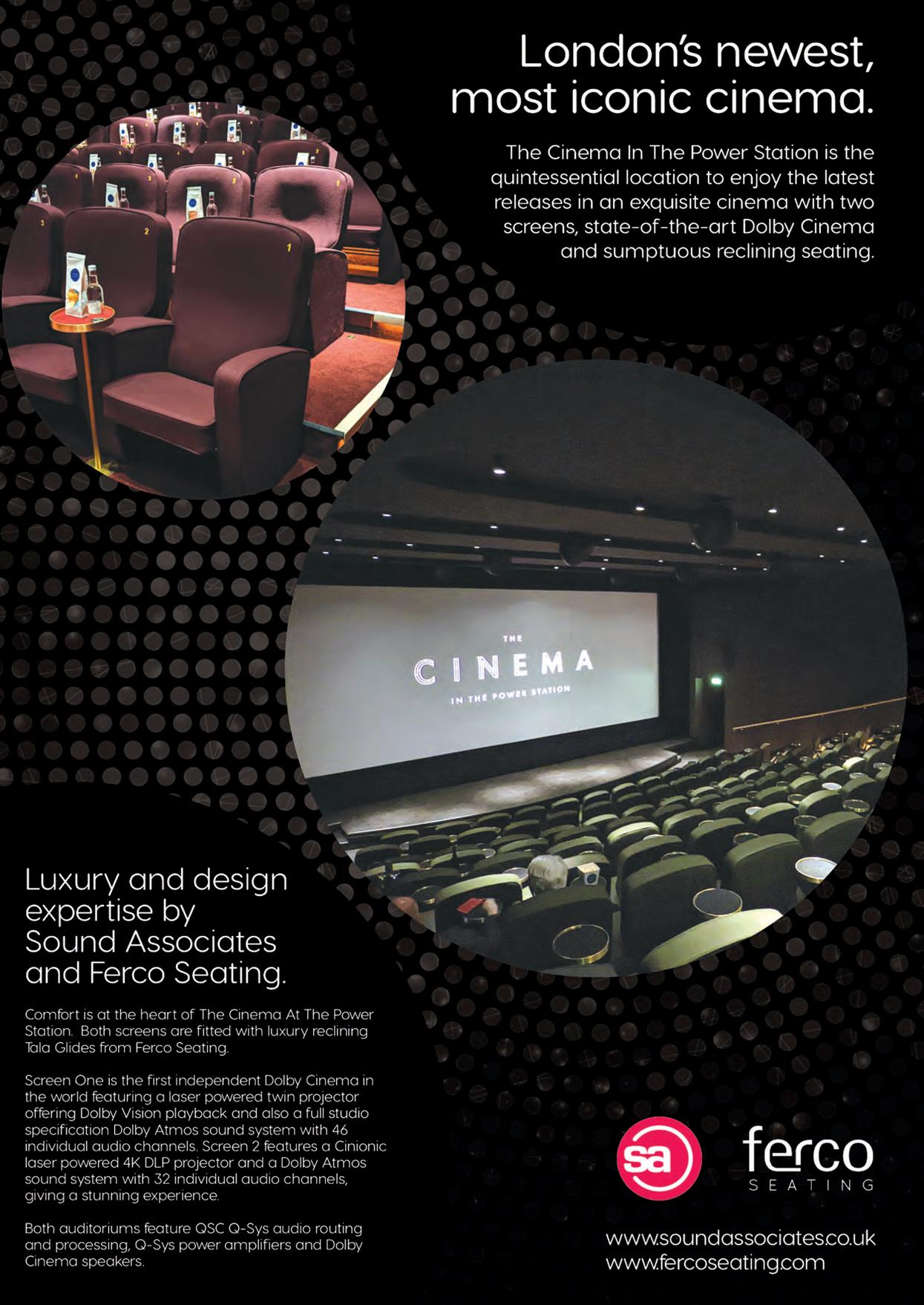
As the UK & Ireland box office cruises past £850m for the year to date, forecasters start to focus on the likely end-of-year numbers. Will 2022 be the first year since 2019 to pass the significant £1 billion milestone? Given the strength of the fourth quarter (Q4) releases, the smart money says yes.
Over the first 45 playweeks of the year, 2022 is close to doubling the total achieved by this point in 2021 – currently 90% up – and will soon exceed by three times 2020’s full-year total. We remain 25% behind the pace of 2019 (which passed £1 billion in early October of that year), but encouragingly this is driven more by supply-side issues than flagging of audience demand; there are simply fewer major releases hitting screens than there were pre-pandemic. The number of “saturation” releases (playing in 250+ cinemas) has fallen by 23%, currently at 124 titles for the year to date, compared to 162 in the equivalent period of 2019. The total number of releases is also down but only by -5% versus 2019; it is in the blockbuster segment that we are feeling the impact of pandemic production and post-production delays.
The same pattern is seen in North America, other European territories and across the world as day-and-date releases of many major titles have been pushed into 2023, including “Spider-Man: Across the Spider-Verse”, “Puss In Boots: The Last Wish” and “Shazam! Fury of the Gods”. Expectations are that the release calendar will stabilise and deliver more regular big hitters in 2023, particularly from May when the early summer release pipeline starts flowing.
At the time of writing, there has been little change in the top 10 films since last quarter, with summer releases “Minions: The Rise of Gru”, “Elvis” and “Thor: Love and Thunder” moving up the chart but no new entries post-July breaking in. Supporting the top tier of releases, very robust audiences have shown up for diverse genres, including Japanese anime (with both “Jujutsu Kaisen 0” and “Dragon Ball Super: SUPER HERO” passing £1m), original animations (“DC League of Super-Pets”, “The Bad Guys”) and horror titles (“Smile” and “Scream”).
Only two of the year’s top 10 films to date were released without 3D or IMAX versions, due to targeting a young family audience: “Sing 2” and “Sonic the Hedgehog 2”. The prevalence of 3D and IMAX releases in the top 10 underlines the importance of premium formats in ‘eventising’ a film’s release, driving audiences to see it on the biggest screen with
immersive visuals and sound, rather than waiting to watch at home (and, of course, the premium ticket price has boosted these films’ revenues). Taken together, 3D and IMAX screenings account for almost 5% of the total box office.
While none of the films released between August and October cracked the top 10 in 2022, with “Black Adam” currently holding the No.12 spot, the final eight weeks of the year promise to reignite the box office. “Black Panther: Wakanda Forever” opened in November with a weekend gross of £12.3m, on a par with pre-pandemic “Captain Marvel” and ahead of current 2022 leader “Top Gun: Maverick”’s threeday opening. By the end of its run, it should be challenging “Doctor Strange” and “Minions” for third place in the annual chart.
Market share of IMAX ticket sales remains over 3%, having grown from 2.25% of the overall box office in 2018 and 2019, to 2.5% in 2020 and peaking at 3.5% in 2021. With the second “Avatar” still to come, 2022’s IMAX share is holding steady at 3.2%, delivering £27.2m of ticket sales (year to date). Following “Spider-Man: No Way Home”’s huge impact in the new year, the format continued to deliver for “Uncharted” (scoring 6.2% of its box office from IMAX screenings), “The Batman” (6.9%), “Top Gun: Maverick” (7.4%), “Thor: Love And Thunder” (5.8% including IMAX/3D) and “Black Adam” (6.4%).
In the build up to “Avatar: The Way of Water”, 3D is enjoying a resurgence. After falling below 5% market share pre-pandemic and just 1.5% in 2021 – when only “Spider-Man: No Way Home” achieved over £1m in 3D ticket sales – three of this year’s major releases have scored more sales in 3D
than IMAX. “Jurassic World: Dominion” achieved 8.2% of its £35m gross from standard 3D screenings (rising to 9.1% including IMAX/3D), while “Doctor Strange in the Multiverse of Madness” made 7.1% of its £42m from standard 3D screenings (rising to 8.5% including IMAX/3D). Most recently, “Black Panther: Wakanda Forever” achieved 9.4% of its opening weekend revenues from 3D shows (and 11.8% when we factor in IMAX/3D). Overall, 3D screenings have driven 1.6% of 2022 box office revenues to mid-November, which will be boosted further as “Black Panther” continues its run and “Avatar: The Way of Water” is released.
Some audience segments are treating themselves to premium experiences at the cinema, shown via several recent films with higher-than-average reported spend in our PostTrak exit polls. Interviewing takes place in the same cinemas each week with filmgoers (aged 13+) reporting their total spend including tickets, food & drinks and any other purchases. Since September, audiences have reported above-average spends on the “Avatar” reissue, “Ticket to Paradise”, “Smile”, “The Woman King”, “Halloween Ends”, “Prey for the Devil”, “One Piece Film: Red” and “Black Panther: Wakanda Forever”. Many of these played in premium visual
formats, while others attracted an older audience who may have more disposable income. However, in light of the current economic issues, we continue to monitor average spend per head and there are signs that this is starting to fall; over the last two months it has dropped to £8.11, from £9.38 in Q3 and £9.20 in the equivalent October/November 2021 period.
Three more of 2022’s expected top 20 films are being released now in the final six weeks of the year – “Roald Dahl’s Matilda the Musical” and Disney’s “Strange World” were at the end of November, and the highly-anticipated box office juggernaut of “Avatar: The Way Of Water” in mid-December. “Strange World” has released in 3D, “Avatar: The Way Of Water” in 3D and IMAX/3D, while “Matilda” is being eventised, with sing-along screenings a few weeks after its initial release, from Christmas Day. The recent two-week long reissue of the first “Avatar” instalment was heavily weighted to premium formats with 86% of its £2.7m ticket revenues coming from 3D and IMAX/3D shows, suggesting that audiences are keen to reimmerse themselves in the land - and seascape - of Pandora. Looking ahead to January, the traditional awards season will rely less on premium formats and more on quality story-telling. Adult audiences will be spoilt for choice with “A Man Called Otto”, “Empire of Light”, “Babylon” and “The Fabelmans”.
With more than 800 members in over 80 countries, Cinema Technology Community (CTC) is the world’s leading independent, not-for-profit trade organisation providing valuable educational resources to the global cinema industry.
With a highly engaged global community and a regular stream of content designed to help the industry improve the movie-going experience for consumers, CTC is the go to place for cinema industry executives.
And what’s more, it’s completely free to join because, at CTC we believe that the industry is stronger and better when we all learn and share together, so we’ve removed the biggest barrier.

Join our global community today for FREE by visiting www.cinema-technology.com
With continued thanks to our sponsors: Admit One, Christie Digital, DX, Ferco Seating, Harkness Screens, MAG Audio, QSC, RealD, Arts Alliance Media, Audio Network Distribution, Compeso, Dolby, GDC Technology, Movio, Sharp/NEC and Strong/MDI.
THE GLOBAL CINEMA TECHNOLOGY NETWORKDTS introduced the Digital Theater System to the world in 1993 with immersive sound in the blockbuster film, “Jurassic Park”, forever changing the game...
Yet, in addition to transforming the cinema experience, DTS now applies its future-focused mission to bring solutions to wireless home audio, incabin connected car sound and sensing, and home theatre experiences. With 30 years of experience and innovation, DTS has delivered a ‘Dedication to Sensational’. DTS’ journey began with a dream of creating an audio experience as engaging and authentic as the dinosaurs on the screen.
Before DTS, theatres projected film with two-channel audio on an optical track printed alongside the sprockets. Thanks to the foresight of Terry Beard, a Caltech-trained engineer with a 20-year history of inventing stereo optical recording equipment, digital audio caught a big break. A friend offered an introduction to Steven Spielberg, and Beard knew he’d have only one chance to make his mark.
world-class mixing stages in 15 countries have installed DTS:X production tools
Beard remixed scenes from “Close Encounters of the Third Kind” in DTS and presented them to Spielberg. The world-famous director nearly leapt from his chair.
“I was flabbergasted,” Spielberg said, and recalled switching back and forth from the traditional soundtrack to DTS, “It [DTS] sounded exactly like a 70 millimeter six-track sound.”
While other digital audio codecs compressed their soundtracks onto the film’s limited real estate, DTS brought uncompressed 5.1 audio into the cinematic audio experience, initially via synchronized optical disc.
With Spielberg’s and Universal Studios’ “Jurassic Park” soon to be released, DTS deployed its digital audio hardware in over 2,000 theatres. If you know your cinema technology history, then you will also note how similar this was to the first steps into the talkies when movie audio was produced using shellac records that played in sync with the celluloid film running through the projector.
Streaming content is saturating the home entertainment landscape, making it more challenging for new releases to find a foothold in this crowded terrain. As audiences stayed home during the pandemic, this only exacerbated existing hurdles to bringing people into theatres.
By positioning cinemas as entertainment destinations, a premium experience that can only be had with a night out means that theatrical releases screened in premium large format (PLF) theatres stand out. This has also facilitated cooperation between the production and distribution studios and the exhibitors, bringing excitement to coming releases with event-driven campaigns and advance-ticketing opportunities.
Because of these advantages, the number of PLF theaters is growing exponentially. According to the latest report from Omdia, the number of PLF auditoriums has more than doubled since the mid-2010s. By the end of 2020, there were close to 6,400 PLF screens globally.
Yet the cost of licensing prescribed PLF formats can be prohibitive. This has encouraged many exhibitors to create their own PLF experiences. Instead of relying on proprietary technology, companies such as American exhibitor, B&B Theatres’ Grand Screen, or Korean exhibitor CGV and their ScreenX PLF theatres, have installed screens as wide as 60 feet, also liberating themselves to choose the best audio solution for the experience. DTS:X was designed with these deployments in mind. Since its debut in August 2015, DTS:X has enjoyed worldwide adoption by major Hollywood motion picture studios, cinema owners and mixing stages. To date, more than 300 theatrical titles have been released and exhibited with a DTS:X soundtrack, over 1100 screens around the world have installed or are committed to add DTS:X, and more than 120 world-class mixing stages in 15 countries have installed DTS:X production tools.
DTS:X Cinema is designed to take full advantage of the freedom of being built on the royalty-free, non-proprietary MDA object-based audio to achieve an optimal immersive experience from the very best and most elaborate cinemas, as well as within more modest cinemas where physical limits and cost constraints prevent adopting PLF installations.
DTS:X Cinema speaker configurations can be divided into two components: the base layer and the height layer. The base layer covers all the speakers in a typical 5.1 or 7.1 cinema, plus any added to fill the gap between the surrounds and the screen. The height layer covers all the speakers added to support height effects anywhere above the base layer. DTS:X permits configuration options for both base layer and height
layer speakers. Once all of the base and height speaker locations have been fixed, a Speaker Configuration File is created that allows the MDA processor to generate the appropriate speaker feeds for each speaker and array. Sounds may be delivered to a single speaker or address an entire array as a group. This means that there’s no predetermined theatre specifications, implementations can be scaled to any multiple of theatre sizes. In short, DTS:X builds additional quality into the source to ensure the ultimate playback experience for cinema and beyond. And DTS:X does all this royalty-free, meaning that exhibitors can charge a premium admission fee without worrying about DTS collecting a portion of the box office receipts.
Another notable aspect of DTS:X is that it doesn’t require proprietary equipment. Exhibitors can use already existing speakers or employ any of the many DTS:X-certified hardware solutions. Certification is achieved by complying
A consistent visionary for 30 years, DTS’ main goal has always been a more immersive, more enjoyable audio experience. With DTS:X in thousands of cinemas worldwide, this aim to give audiences authentic, stimulating and reliable sound is nearly realized.
When SMPTE created the standardized immersive audio bitstream (IAB), they ensured that a single IAB digital cinema package would be interoperable with IAB immersive-sound-supported theatres. This streamlines the contentfinishing process and reduces the number of mixes and cinema masters producers and distributors have to make. A simplified digital content package (DCP) for theatrical distribution and DCP management in theatres, enables studios and content creators to supply fewer audio versions for each movie.
Loren Nielsen, Vice President, Content Relations and Strategy for DTS’ parent company Xperi, says of the DTS:X difference, “IAB opens the door to broader DTS:X adoption in theatres and plays a critical role in enabling studios to reduce their overall title mixing and mastering versions. DTS:X for IAB also supports high frame rate content.”
DTS:X for IAB has already been implemented via beta sites capable of DTS:X for IAB playback in theatres across Hong Kong, Singapore and France. Plans for further deployment, with many theatres transitioning to DTS:X for IAB will be enacted in January 2023.
with the DTS:X installation guidelines and installing DTS:Xcapable equipment available from industry-leading servers, sound rendering/processor companies and speaker manufacturers, including GDC Technology, QSC, ADDE Audio, Delair Labs, DK Audio, Elipson, JBL, KCS, Klipsch, Meyer Sound and Trinnov

ovio’s data science tools are designed to take the guesswork out of customer segmentation - i.e. no more extensive filtering to guess defined audiences. These data science features use multiple algorithms to analyse cinema audiences’ past behaviours and then predict how likely they are to watch a given movie. This helps marketers find the best audience for each film and identifies untapped opportunities to drive attendance, incrementally. As a result, audiences receive more dynamic, personalised communications, connecting them to their ideal movies and helping to deliver an overall improved customer experience.
As an example of the results of their data science tools, in a direct analysis of the opening week of “Black Panther” (Feb 16, 2018), the moviegoing behaviour of visiting members revealed that 55% saw Movio’s number one recommendation. 68% saw a movie in their top two recommendations, and 78% saw a movie in their top three recommendations.
Movio’s “Propensity” algorithm analyses an audience’s past behaviours and predicts how likely an audience is to watch a given movie. Propensity allows users to deliver a tailored customer experience, connecting each moviegoer
to their favoured films. The above study also showed that, when using Propensity, the cinema was able to achieve a 5.9x visitation rate, compared to an average unfiltered email send.
Movio’s new intelligent data analytics and campaign management solution, Movio Cinema EQ, was launched on November 8, 2022. It builds on more than a decade of movie marketing expertise displayed in Movio’s current products and is designed to offer cinemas a smarter, more streamlined solution towards their campaign management.
The product brings Movio’s aforementioned data science tools to the forefront of their campaign creation, enabling marketers to easily create communications that result in more successful campaigns.

EQ gives marketers the ability to more easily transform data into insights, insights into actions, and actions into a measurable impact on their business. The new product also offers insights and automation that end up producing a more sophisticated campaign. By taking the guesswork out of targeted marketing, cinemas can enhance their connection with their audience, driving guest engagement and, ultimately, increasing attendance and spending.
With new features designed with the customer experience in mind, cinemas can leverage EQ to create more
CT Magazine talks to marketing solutions and data analytics firm, Movio, to learn about their new EQ product and what it can do…personalised interactions with their members that have them returning more often.

EQ also introduces “journeys” to users. Journeys are automated, real-time triggers that are omnichannel, multivariate, and dynamically populated campaigns. These are both pre-configured and customisable based on business goals and desired guest experience. With EQ’s journey builder, cinemas can create sophisticated customer journeys, giving marketers the power to deliver more memorable interactions throughout their guest experiences.
“We’ve designed EQ by putting moviegoers at the centre of the strategy. Being able to connect people with their ideal movie via the digital marketing channels where they are spending their time and with smarter, more personalised campaigns, has never been more important. EQ addresses these needs while also providing an elevated user experience for our cinema clients. We’re excited to see the positive impact our technology will have in building frequency, spend and cinema brand loyalty,” says Sarah Lewthwaite, CEO, Movio. In addition to personalised content, cinema marketers can expand beyond members, finding customers in their channel of choice, resulting in higher click rates and increased revenue.

EQ’s reporting provides users with a holistic view of their campaign’s performance, as well as for daily users who are looking to dive into individual campaigns. This reporting function has been enhanced to aggregate all the reporting data across multiple campaigns and data-sets and utilises and highlights insights such as converted moviegoers, admissions, revenue, average spend. With additional levels of detail, users can then clearly pinpoint the effectiveness of their campaign on engagement, awareness, and as well, revenue generated.
Reporting, via Movio’s testing capabilities, also lets users compare their campaigns to a control group or to other campaigns.
CT was given an early view of the EQ product and was able to see the powerful capabilities that it had to offer
This is really going to be a game-changer for cinema marketing teams who want to reach the audience within their database who are going to most benefit from knowing which films are coming up.


Because of its dynamic nature, the product is able to make connections that might not naturally be seen. While products like Campaign Monitor or MailChimp are great for sending out newsletters, EQ adds a whole other level of engagement on top of this in order to make sure the relevant people are always receiving the most appropriate communication, for a specific movie or event.
The ability to always see what the data is saying, whether it is on an individual title or campaign, adds real value. While every single campaign doesn’t write itself at the moment, the EQ product helps to make it an effortless experience - although, with the added automation features, for some campaigns this is actually the case.
This certainly looks to be a product that is going to make a difference to marketers in the industry and their companies, one that will really help cinemas to connect with the right audience at the right time in the right way with the right message.



According to industry data sources, at the end of 2019, there were still over 62,000 Series 1 and Series 2 projectors in operation with exhibitors that have completed, or are near to completing, their VPF. Despite these now being fewer in number (although this figure is the most recently available), in part due to the increase in the use of laser projection, this report aims to achieve the best possible results with Series 1 and 2 projectors still in circulation. Without the presence of a second VPF and with projection equipment lasting beyond industry expectation (albeit potentially not operating at the levels seen when new), exhibitors face difficult decisions as to how best to continue to provide their customers with the best possible movie-going experience whilst taking into consideration opex and capex requirements.
This report aims to highlight the need for exhibitors to, where necessary, do something to ensure that the quality of the movie-going experience is being maintained. The document is designed to showcase the benefits in terms of brightness (and, potentially, contrast and colour) output that can be gained by uplifting existing Series 1 and 2 projectors and related equipment. However, it is important to note that deploying new laser projectors (both phosphor and RGB) have their own significant advantages in terms of brightness, contrast, operating cost efficiencies, long warranties, etc. and that CTC is not advocating one over another.
Careful consideration should always be given to individual circumstances and, where necessary, exhibitors should always seek guidance from their integrator/installer or from the equipment manufacturer directly.
CTC would like to place on record its thanks to Sharp/ NEC Display Solutions Europe, Harkness Screens and GDC
Technology for photography and information relating to products and services in this document.
When considering the placement of the projector, consider any possible risk from dust, dirt, outside environmental dust / dirt (such as air-conditioning outputs or food extractors). The vent intake within a xenon projector is very efficient and will pull any external dust or dirt, putting it at risk of entering the projector. Reducing the risk of dirt, food extracts (popcorn oil, etc.) and dust entering the projector will increase its efficiency. It is not obvious when popcorn oil is entering the projector and whilst the filters will save some elements, the efficiency of some projectors will allow very small quantities to enter.
The air extraction for a xenon projector should be sufficient for the lamp installed. Failure to meet the specification may lead to overheating of the lamp or projector. Exhibitors should also be aware of items stored in the same room as the projectors; cardboard boxes, standees or promotional merchandise should be avoided in the projection room.
Regular maintenance will increase the lifetime of any projector. When replacing the lamp, take the opportunity to clean the lamp housing, reflector, etc. Cleaning of the mirror will lead to an increase of up to 6% of the projector brightness.
Filters within the lamp housing should also be replaced whenever the lamp is changed. Filters within the optical area of the projector should be changed according to the manufacturer’s recommendations. Generally, the usage time of filters is found within the projector menu.
When changing the lamp, take a moment to wipe the
lens, porthole glass and general area of the projector.
Take care not to shake any dust unnecessarily near the projector’s air intake. Follow the manufacturer’s advice as to materials used for cleaning. In most cases, the use of a lintfree cloth (as used with cameras) is acceptable. Do not use any chemicals, which may contain flammable gases.
Regular cleaning of the mirrors within the lamp housing will ensure best performance and, in some cases, increase the brightness by up to 5-6%. Always inspect the mirror prior to cleaning and if there is any sign of deterioration in the mirror itself, you should not attempt to clean the mirror.
Despite all efforts by manufacturers to maintain a dust-free environment within the lens, there are always minute particles, which work their way through the seals during the zoom process. These particles will slowly collect on the inside of the lens and over many years will affect the performance of the projector.
Changing the lens has a small benefit of around 5-6% to the light performance of your projector.
Regardless of how much you clean the lamp house, the buildup of dirt will always occur. When the projector brightness reduces to an unacceptable level, it may be beneficial to replace the lamp house. The changing of the lamp house will allow for an increase of light of up to 60% within an existing projector.
A prism is a working component, drawing minute dust particles. Over time, the image quality on screen will reduce due to dust collection on the prism or DMD mirrors. The image quality will significantly improve with the cleaning of these components. The age and use of the prism will determine the impact of cleaning. In some cases, the cleaning
All results are based on real examples, but can vary according to projector, lamp and environment.
of a prism can increase the light output of a projector by more than 30%. The projector manufacturer, to ensure accuracy and realignment of the prisms, should manage prism cleaning. The manufacturer will generally look to clean the prism glass surfaces, and blow out any dust between the components where cleaning is not possible. The DMDs should be individually removed, and realignment made upon reassembly.
In some situations, the prism or DMD chip may be too old or too dirty to guarantee cleaning results. It may be that the cost of such outweighs the benefits. In this case, manufacturers can offer a replacement of the prism. When replacing it, they will also ensure other components around the prism are cleaned and in good operation.
As
Cinema screens can remain installed for in excess of 10 years and there is a high probability that many would have been installed along with S1 and S2 digital projectors and left unchanged. Screens age and degrade at different rates, depending on a number of factors linked to ambient environmental conditions. Screens that deteriorate can affect presentation quality in a number of ways, from lowering gain (reflectivity) through to depolarization (decreasing extinction ratio) in 3D screens, which can cause 3D images to ghost.
In some environments, dusting a screen can help to improve the screen’s performance, however, advice should always be sought from the screen manufacturer prior to undertaking such work.

But aged screens in less-than-perfect environments can lose around 25-30% of their reflectivity, which will, in turn, affect on-screen brightness. This will also increase operational costs from running xenon lamps at higher power settings for longer, or replacing lamps with higher wattage lamps to generate sufficient on-screen light.
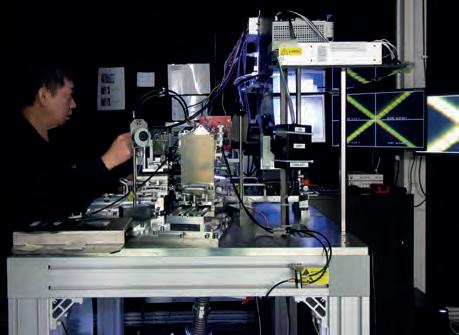
Clockwise from top: correctly aligning a replacement prism with the alignment tool; an older prism, pre-cleaning; a cleaned prism; an FCB board
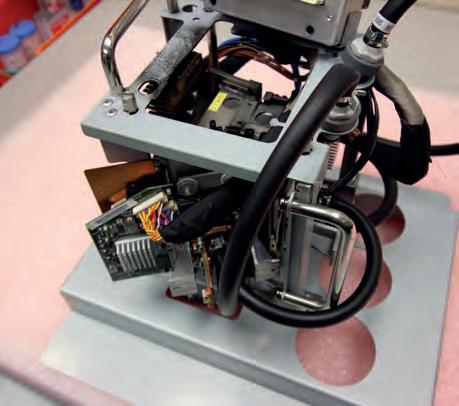
Determining the precise condition of a screen is complicated and requires accurate measuring. Some screen manufacturers are capable of supporting screen measurement programs or advising you on how to measure the screen condition.
Revisiting your screen selection may also be advisable from an economic standpoint. It is possible to replace your existing screen by making small, incremental uplifts to the gain of the screen without dramatically changing presentation quality in terms of uniformity of presentation. Uplifting the gain of the screen will, of course, reduce operational costs. The cost of replacing a screen depends on the type and size of screen required. A mid-sized silver screen can cost around €6,000, including installation costs.
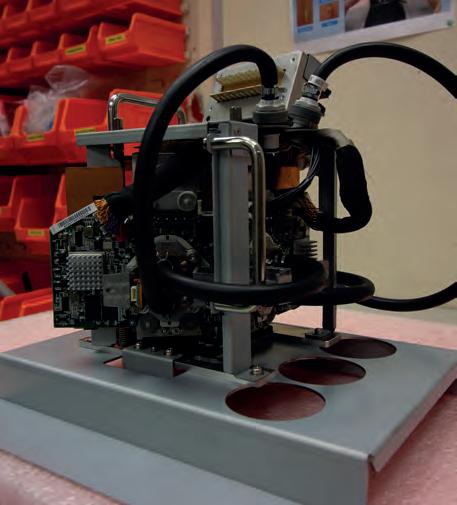
3D systems installed during digitisation typically had a light efficiency of between 10-12% (active 3D systems) and 15-18% (z-screen polarized systems). This meant that between 8290% of light output from the projector would be lost (3D polarizing system, screen, eye wear) during the process of projecting 3D images. Similar to projectors, 3D systems acquire dirt and dust, which can affect their initial light efficiency.
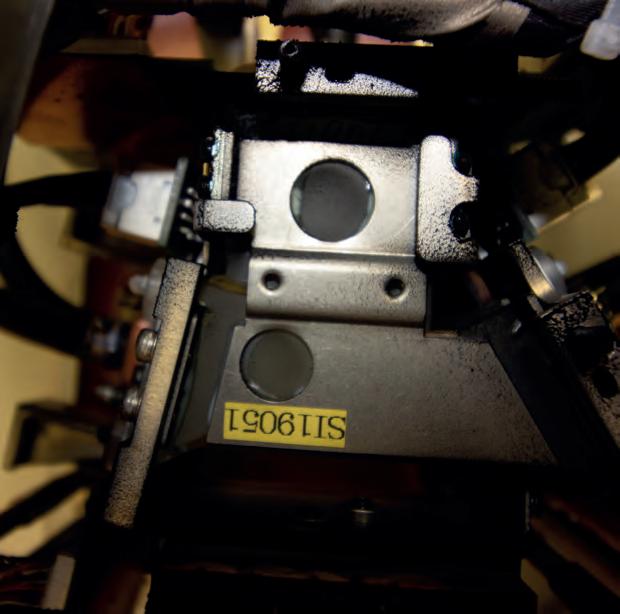
Cleaning 3D polarizing systems to remove dust is recommended but any additional cleaning methods should only be undertaken following discussions with the equipment manufacturer. Minor improvements in light efficiency can have a significant impact on brightness output.
The table below assumes a polarized 3D system with an as-new LEF of 16%.
To aid with the projection of 3D images on larger screens or to enhance 3D brightness levels, a number of lightdoubling or light-tripling systems exist with light efficiency values of between 23-32% which have the potential to more than double 3D brightness levels.
As with other equipment, it is essential that port glass is cleaned regularly to remove dust and dirt. Typically, port glass allows the transmission of 98%+ of light from the projector; however, a build-up of dirt and dust on either side (projection booth or auditorium) of the glass can lower the transmission by as much as 15%. It may also be worth considering replacing port glass where necessary.
If you’re embarking upon an upgrade program to your existing S1 or S2 equipment, which could prolong the life of your projection equipment for a number of years, it may be prudent to consider replacing the original projector server to a new generation IMB (integrated media block). As well as extending the life of your current projector, this route can offer an easy upgrade in the future when a new projector is
purchased. There are a number of modern standalone media players available with kits supporting Series 1 projectors. These kits are rack-mountable enclosures typically consisting of the latest generation IMB and possibly some redundant hot swappable storage. Together, this becomes more like a ‘separated server’ than an IMB, as it is not actually integrated in the projector. When replacing a Series 1 projector, the IMB can be detached and seamlessly plugged into Series 2, 3 or 4 DLP cinema projectors. Upgrading the IMB in a Series 2 projector is even easier, given that a separate kit is not required.
As well as two BNC connectors for HD-SDI connections to a Series 1 projector, these modern standalone media players also deliver benefits today – including larger storage capacity, HDMI outputs and current warranty cover. And it is also an investment for the future as the IMB could be 4K and HFR capable, for example.
Top: the light path through a prism; a busy audience watches a film
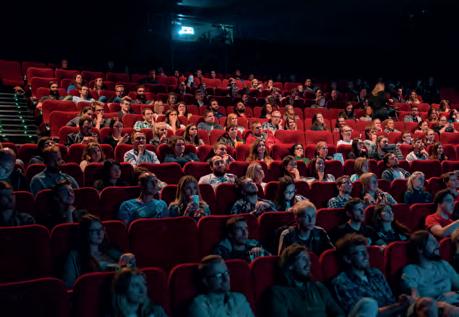
In this second example, the same exhibitor focused on uplifting not just the projector but the screen and was able to benefit from significant improvements in presentation quality. By cleaning projection mirrors, replacing the lamp house and swapping a degrading white gain screen (1.2 gain) with a higher gain white screen, the exhibitor was able to more than double the on-screen brightness of their image.
As well as improving presentation quality, and therefore providing a better movie-going experience for your customers, there is a financial return to be measured prior to undertaking any work. ROI (Return On Investment) varies depending upon the benchmark by which you are measuring. And it is equally vital to determine the alternative options to renovating/restoring existing equipment in advance to help determine the scale and expected payback on the investment - and whether it is a sound investment.
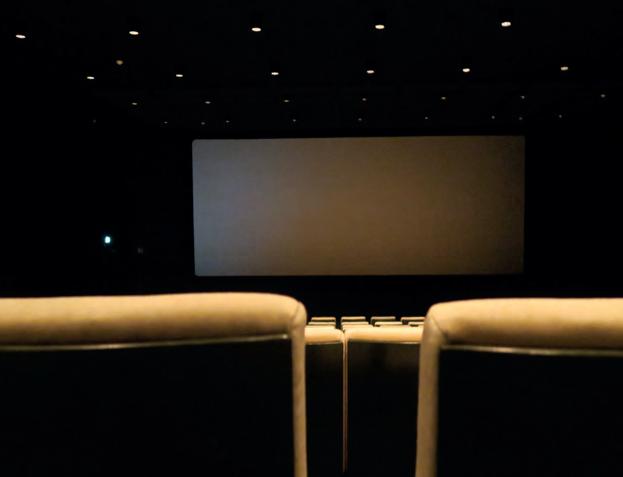
Exhibitors could look at two different measures to determine ROI:
Uplift cost vs operating cost reductions (power and consumables)
Cost of uplift vs new projector installation or retrofit laser light engine
Taking the second example, the exhibitor was able to reduce power levels in the projector and in the process, replace their existing 4kW xenon lamp with a 2kW lamp (with longer warranty hours). The exhibitor noted an operating cost reduction in excess of €2,500 per annum, equating to a fiveyear return whilst also receiving significant praise from their customers for delivering a far superior presentation.
The exhibitor determined that from an on-screen brightness perspective alone, replacing the existing equipment with a new projector or a retrofit laser light engine would yield the same result - however, this would be with a larger upfront cost and a longer ROI, albeit with long warranties and improvements to contrast and operating costs.
Understand what you are trying to achieve in order to make informed decisions. You should check with your projector manufacturer to determine whether your projector components can be cleaned or replaced and also to identify current and expected long-term availability of spare parts for your projector. Given that the condition of the screen can also dramatically affect presentation brightness, ascertain the age and state of your screen.
You should, where you feel necessary, seek guidance from your integrator/installer or product manufacturer in order to ensure that any investment you make in legacy equipment is future proofed as best as it possibly can be.
Whatever size, brightness or flexibility you need, the NEC ML DC Laser Projectors deliver the ultimate theatre experience.
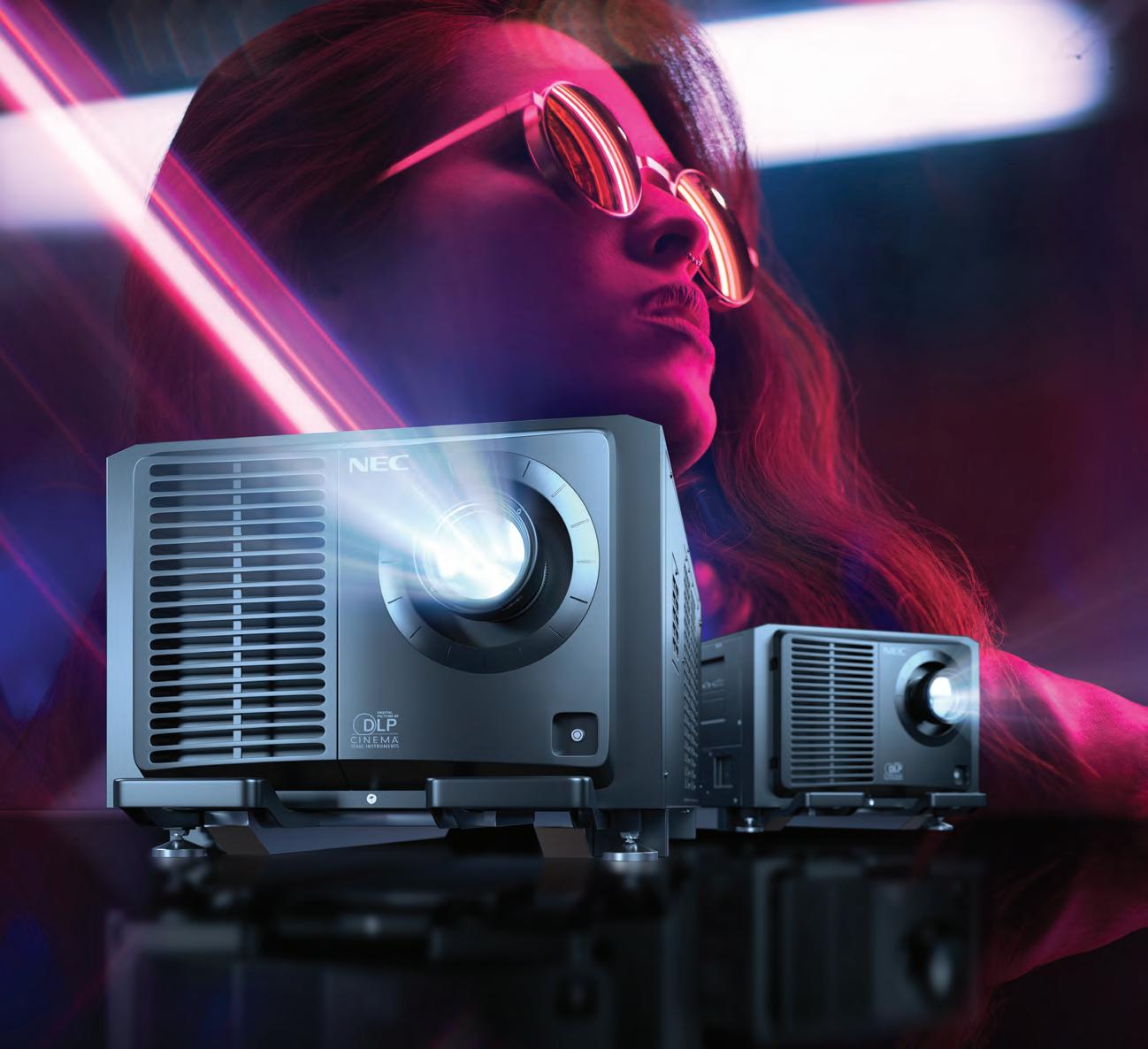
Captivate your audience with ultra-crisp almost speckle-free RB Laser technology with 18, 20 or 24,000 lumens and 2K or 4K resolutions, whilst benefitting from lens inter-changeability with the NC2000 Series.
Visit sharpnecdisplays.eu
Firmly in winter-coat-end-of-the-year season, the ICTA gives us an update on an exciting new partnership, how 2022 has played out for them and how 2023 is looking.
2022 was a very busy and successful year for the International Cinema Technology Association. The January ICTA Los Angeles Seminar Series (LASS) attracted more than 200 people to Universal City, California, and continues to be one of the best networking events for the motion picture industry. A few months later at CinemaCon, Las Vegas, we held our annual membership meeting and reception, and in June, our international division conducted the presentation of the EMEA cinema awards at the Barcelona Seminar Series at CineEurope.
We are delighted to announce that the ICTA has concluded a partnership with the newly-created Cinema Foundation on the Los Angeles Seminar Series and will be working closely with them to expand the scope of the event, attract more industry people and focus on the educational aspects of the three-day event in California. The Cinema Foundation was formed as a 501(C)(3) organization in March 2022 under the auspices of the National Association of Theatre Owners (NATO).
I have also been asked to serve on the board of the Cinema Foundation (CF) and am truly honored to be a part of this forward-thinking group. Together with the CF, I believe that the ICTA will be able to achieve some of our primary goals of helping to educate the industry and create a professional training and technical program. This partnership will help encourage innovation in the cinema experience and
support educational opportunities and availability within the industry.
This partnership will also help to define the new ICTA going forward as we continue to be the vehicle to collaborate between cinemas and the technology community. Additionally, it will lead to more positive outcomes for the motion picture industry.
As our first official collaborative effort, ICTA will host the annual 2023 LASS series in partnership with the Cinema Foundation, January 9-11, at the Universal Hilton in Universal City, California. The LASS is a three-day seminar dedicated to networking, educational, and industry-relevant programming with exposure to the newest technology trends in cinema.
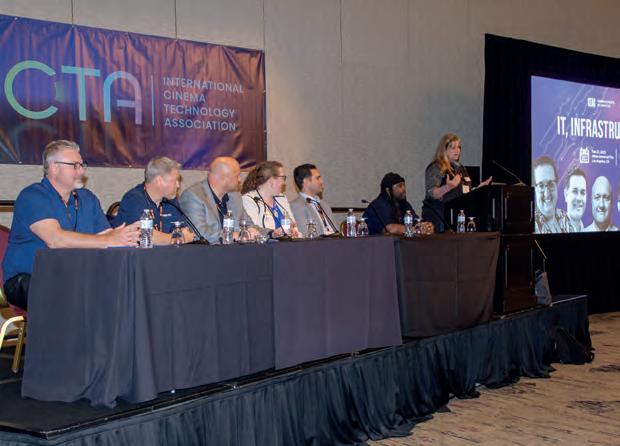
This year, a new joint programming committee, including the Cinema Foundation, has developed a number of topics
A panel on upcoming projects in the Middle East (META Cinema Forum 2022, Dubai)
IT infrastructure panel (LASS series 2022)
to appeal to exhibitors, technology providers, and others associated with motion picture exhibition.
Some of the highlights of the program include::
The importance of cinema software
The new Cinema Foundation and the importance of innovation and technology
Tax credits for small businesses
What is a premium theatre experience?
A demonstration of Light Steering technology
What brings people back to the movies - a data-driven discussion
Member presentations & more
As always, the program includes an off-site visit to a local facility of particular interest to technology professionals in the motion picture exhibition industry.
The program also includes a closing night banquet with the presentation of the North American Cinema Awards, which recognizes outstanding achievement in three areas: Best Newly Built Cinema, Best Cinema Refurbishment, and Best Use of New Technology in a Cinema. This awards program follows on from the annual EMEA awards, which are part of ICTA’s Barcelona Seminar Series, held each summer during CineEurope.
Many ICTA members attended the META Cinema Forum in Dubai in October, which, over the last five years, has put the rapid development of the cinema exhibition sector in the
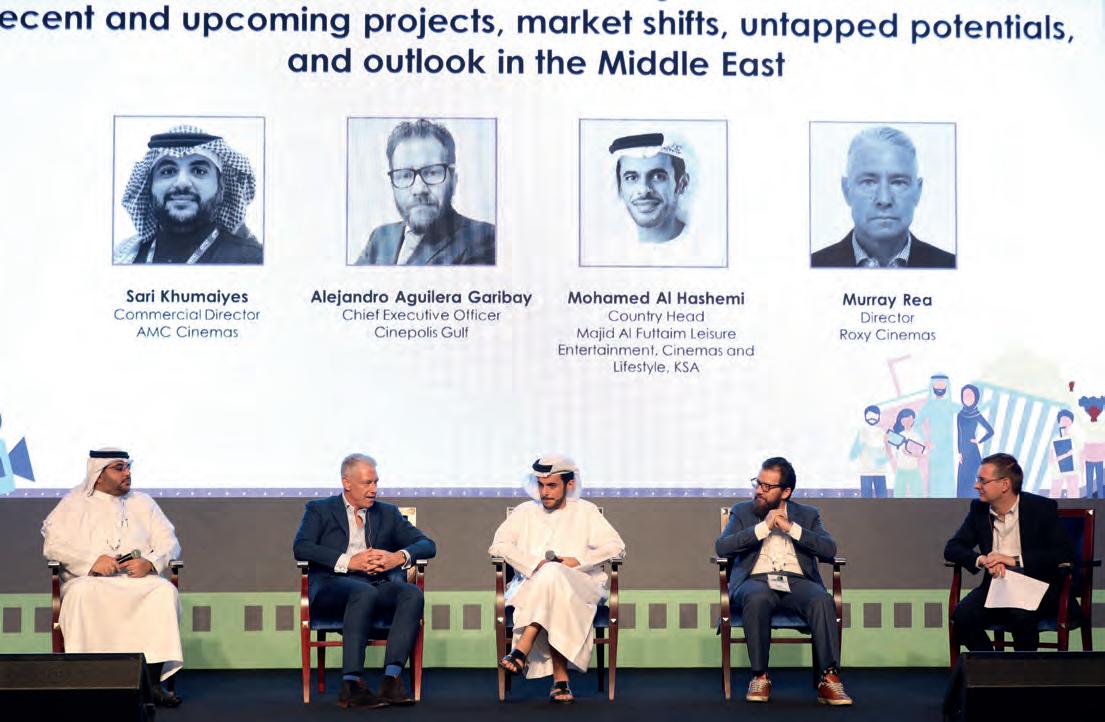

Gulf region - as well as further emerging markets - under the spotlight. For the first time, ICTA partnered with META Cinema Forum and provided its members with a discount for registrations and was named a key partner of the event. Going forward, we will look to further add value to members participating in the event by organizing panel presentations under the ICTA brand and possibly introducing Members’ Presentations.
A more recent event was UNIC’s Cinema Days, which took place 24-25 November in Brussels, Belgium. ICTA’s international directors took part in this exclusive networking event and represented the association in the cinema technology sessions, which took place on the second day of the event.
Members should also take note of two important events happening in 2023. We plan to collaborate with Germany’s cinema convention taking place from 8-11 May in BadenBaden by organizing an ICTA-led panel discussion and a cocktail reception. And, as usual, our annual Barcelona seminar series will be held during CineEurope from 18-22 June 2022. www.ictaweb.com
As we draw to the end of 2022, we have seen encouraging spikes over the course of the year across a range of event cinema titles. With nearly 90 new events released to date - a significant increase compared to 2021 - event cinema is back on a solid trajectory, which is, indeed, reflected in the box office.
At the time of writing, the UK and Ireland box office has surpassed £17.5m (excluding Secret Cinema) with some pockets of credible success over the course of the year. The most notable is NT Live’s “Prima Facie”, which has grossed in excess of £5.5m at the UK & Ireland box office, making it the biggest event cinema title of all time, smashing the previous record for “Fleabag” back in 2019. And it is interesting to note that these top two performing titles for event cinema have been solo female performances with titles that have attracted audiences from a wide range of age demographics. In fact, the top 10 titles of the year - by genre, not box office - are somewhat reminiscent of 2019, where we have had a strong year for theatre and concerts (see Top 10, above right).
More recently across Europe, the Filmed for IMAX Concert: “Indochine Central Tour in Cinema”, distributed by IMAX and Pathé Live, grossed £2.23m across France and selected territories. In France alone, the event welcomed over 120,000 fans and took over £2m in box office, making it the biggest event cinema release in France.
These notable events over the year are encouraging, and although we’re not quite back at previous levels, we are seeing more promising numbers for events that do traditionally appeal to older audiences. Most importantly though, we’re seeing a wide range of events back on offer for exhibitors.
JAN £862,606 FEB £965,665 MAR £1,479,355 APR £620,922 MAY £1,597,560 JUN £607,123 JUL £5,001,072 AUG £3,491,835 SEP £1,015,276 OCT £2,447,265 NOV £1,875,045 TOTAL £19, 963,724
Also at the end of 2022, the Event Cinema Association (ECA) entered its 10th year of operations and to mark the occasion we are delighted to announce the return of ECA’s Slate Day, back in its usual spot of 2023’s first quarter. The annual event, now in its sixth year, will take place on Thursday 26th January at Empire Cinema Walthamstow, London.
With a stellar line up of presentations already confirmed from Trafalgar Releasing, Piece of Magic Entertainment, Pathé Live, Nexo Digital, Version Digital, Exhibition on Screen, Generation Media, Compassionate Films and Anime Ltd, the day is shaping up nicely. As we know with event cinema, new events come on to the scene in a relatively short space of time, so we are confident that more will be added to this growing list. Resident event cinema box office guru, Luke Williams, will provide an international review of 2022 and will look back at interesting changes to the event cinema landscape over the last 10 years.
Since the ECA started, access to box office and audience data is stronger than ever and without doubt, it has helped us better track the forever changing landscape of event cinema and the growth of new emerging areas. In the last three years we have seen more diversification in distribution patterns of event cinema content. At previous conferences we have defined event cinema either by the type of content or by the methodology of release - typically a one-night-only release model - however, the pandemic taught us to adapt, and earlier this year the importance of this was questioned.
At the UKCA conference in April we discussed how the event cinema model offers a great platform to trial new events, anime being a prime example of this. As anime is now more mainstream it has something of a question mark over it as to whether it is classified as event cinema content. But how
TRAFR (Released 15/07/2022)
PIECE OF MAGIC (Released 26/08/2022)
TRAFR (Released 11/03/2022)
TRAFR (Released 28/10/2022)
TRAFR (Released 21/01/2022)
an event is marketed is actually a more poignant question. We’ll focus on this and how to make events stand out and be successful. And no anniversary event would be complete without a few awards. As at previous events we’ll recognise the top performing global titles from 2022 for the following genres: opera, concerts, theatre, anime and pre-school, determined by box office, with the latter two being new categories. Alongside this we’ll have the popular ‘Highly Commended’ event of 2022, to recognise a standout event that was unique and successful outside of box office takings.
The event is an opportunity to look back at the last 10 years of the association and event cinema, and we have decided to limit the awards to 10. Whilst half are based on box office, we are calling upon all across the industry to help us choose worthy winners for the other categories - our ‘People’s Choice’ awards. We want you to submit your nominations to recognise events and individuals more widely, those that have evolved the event cinema landscape over the years.
Event Cinema Distributor
Event Cinema Exhibitor
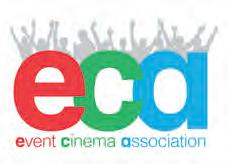
Event Cinema Technology Partner
Best Event
CINLVE (Released 08/05/2022)
TRAFR (Released 17/06/2022)
NT LIVE (Released 30/09/2022)
NT LIVE (Released 11/02/2022)
NT LIVE (Released 02/09/2022)
We want you to share your event cinema highlights – what have been your favourite events and memorable moments (good and bad) over the last 10 years? Which content providers should be recognised and why? Which exhibitors have gone above and beyond in promoting and championing event cinema? Which technology vendors have helped develop and support the delivery of events? Head to our website to find details of the event, to submit votes or please email through your nominations to grainne@ eventcinemaassociation.org. All nominations will be kept confidential.
Finally, no anniversary event would be complete without post-event drinks and 2023 already feels like we will finally have a year of solid content. Tickets are now on sale for Slate Day via the ECA website. We have an early bird offer on until the end of year where you can save 20% on purchases of four tickets. And for event sponsorship details, visit the ECA website.
We look forward to seeing you there and starting the year in style.
Cinema operators globally had to face a challenging summer. Carried by a series of blockbusters and local films, several major markets approached prepandemic performances in June and July, but suffered one of their worst Septembers ever, with a global monthly box office 44% below the 2017-19 average, according to data published by Gower Street Analytics. And this was mainly due to a lack of content. At the time of writing, the total for 2022 is expected to be 35% below the 2017-19 global average, slightly lower than earlier predictions. At a European level, we expect 2022 to be roughly 30% below these pre-pandemic years. The releases of “Black Panther: Wakanda Forever” and “Avatar: The Way of Water” - and the hype that has accompanied the extended trailer in early November - should boost box office results in the last weeks of the year.
In Europe, exhibitors reacted swiftly to the lack of content at the end of the summer, as we saw the launch of a series of national cinema days across the region, most of which took place in September and October. Inspired by existing initiatives such as the French La Fête du Cinéma and the Spanish Fiesta del Cine, these local events have enjoyed highly positive results and are expected to return in 2023 and beyond. In Germany, the first edition of the Kinofest attracted almost 1.1 million visitors for the best weekend performance of 2022. The Italian Cinema in Festa initiative brought in over 1.13 million admissions, a 123% increase on the same weekend in 2021. In Sweden, the Stora Biodagen recorded the best single day performance since Christmas 2019. The first edition of the UK’s National Cinema Day welcomed 1.46 million visitors in a single day. And the Netherlands launched Cinemaniaaa on 2, 3 and 4 November.
Cinemas have also been facing pressing challenges brought about by the ongoing energy crisis, inflation rates and the subsequent effects.
During the annual gathering of French cinema operators in Deauville at the end of September, energy costs were clearly identified as the number one issue for exhibitors of all sizes and locations. The French cinema federation (FNCF) even published a “sobriety chart”, providing cinema operators with a practical list of key actions, enabling them to reduce their energy bill in the coming months and ensure that they respect the official national objective of reducing consumption by 10% towards the end of the year.
Since then, we have seen similar initiatives from local industry bodies across Europe. In Germany, the national cinema association organised a series of workshops which resulted in the creation of a free-to-use digital tool made
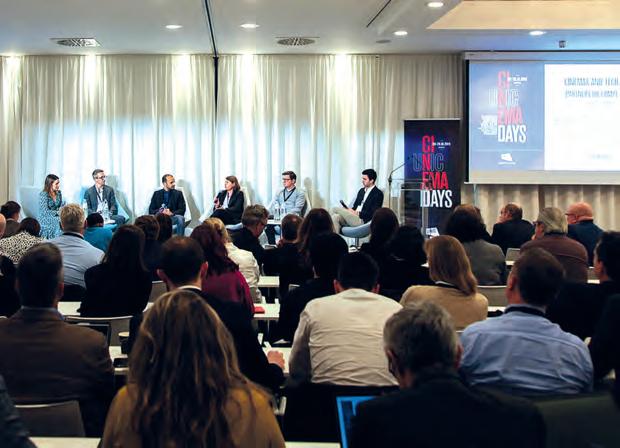
(l-r) David Hancock, Andrew Myers, John Donnelly, Corinne Thibaut, Patrick von Sychowski (UNIC Cinema Days 2015)
(panel l-r) Sarah Lewthwaite, Klaus T. Odegaard, Derren Sequeira, Kate Gerova, Dana Ritter, Michael Zouzou (Cinema Days 2019)
available to all German exhibitors, allowing them to efficiently launch an adapted sustainability strategy with short, medium and long-term measures. In parallel to these sector initiatives, we have seen a few governments launching dedicated support schemes or requirements to adapt to rising energy costs. In the Netherlands, a grant covering a share of the energy cost increase is expected to be launched in early 2023. And at the EU level, energy ministers are trying to find common solutions.
Beyond energy costs, cinema operators are aware that investment in new, sustainable technologies and solutions should not be put aside. Which is why sustainability remains high on the UNIC agenda, with a dedicated panel during the UNIC Cinema Days on 24-25 November, in addition to a
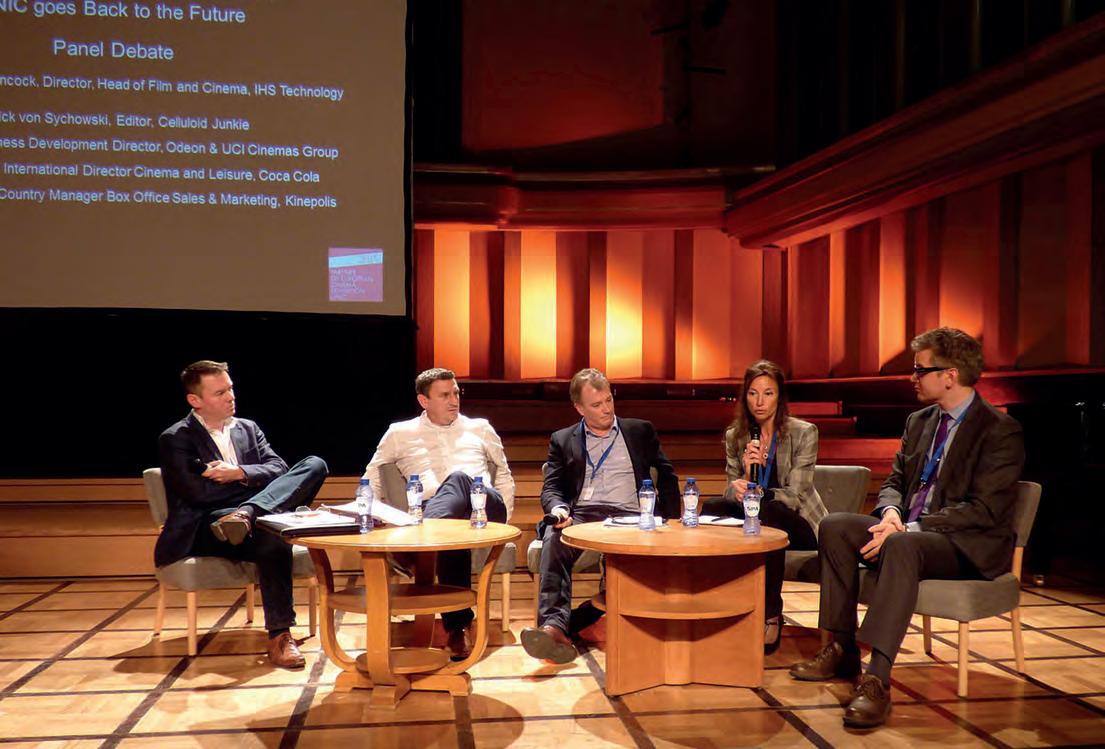
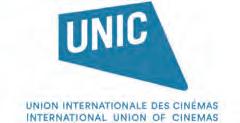
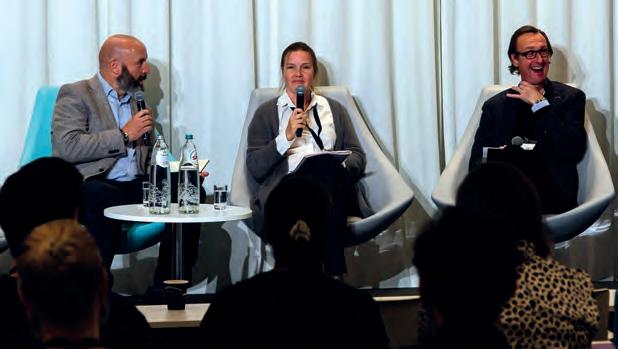
(l-r) Phil Clapp, Louise Vesth, Peter Fornstam (Cinema Days 2019)
session on programming and content diversity. Moreover, the UNIC Technology Group has been focusing on the topic throughout 2022, with dedicated working groups on energy efficiency and laser projection, launched at the beginning of the year. Within these groups, cinema operators have been actively collaborating with major manufacturers to measure the energy consumption of the various equipment pieces within the projection booth much more efficiently. And they’ve been exploring what could be done to make cinema operations more sustainable in the long run.
We have seen cinema operators investing in laser technology - with the technology roll-out expected to accelerate in the coming months - and other sustainable solutions such as solar panels, demonstrating the strength of the industry and its ability to evolve in a challenging environment.
As we wish the cinema industry a highly successful end of 2022, we’d like to invite you to save the date for the next edition of CineEurope, which will be taking place on 19-22 June 2023 in Barcelona. See you at the big screen!
info
www.uniccinemas.org.
CT: Please introduce yourself and your background.
Born and raised in Toronto, Canada, I started working in my local cinema when I was at university. Never at that time could I have imagined that my part-time job popping popcorn would lead to a 25-year career in the cinema industry. While I studied to be a journalist, about the time I was graduating a marketing role opened in the home office of Cineplex [Canada’s largest cinema chain]. My cinema manager encouraged me to apply and, despite me having zero marketing experience, Cineplex took a chance on me.
I then spent the next 17 years growing with the company, building the marketing team, and helping to launch several new brands, products and business units as Cineplex rapidly expanded its footprint across Canada. And I learned so much about marketing, business, and the dynamics of the cinema industry along the way. I also learned a lot about myself and, after 17 years as the Vice President of Marketing, I resigned and made a bold decision to move to Europe, with the idea to open a tearoom.
CT: Tell us more about the move to Europe and the tearoom?
So, the tearoom actually never made it past the concept stage. I did put the prep work in, such as studying to become a tea sommelier (yes, there is such a thing) and learning café management on an organic farm in Cork.
But then out of the blue I got an email from Movio’s founder and then-CEO, Will Palmer, who was looking to open an office in London. They were based in Auckland and LA at the time, and wanted to start growing
their footprint across EMEA. Hearing I was living in Ireland he thought I might be the perfect fit given I also used to be a Movio customer at Cineplex and knew the benefits of the product quite well from first-hand experience. It was another instance of being in the right place at the right time for me as, during that same period, I was starting to doubt my ability to really make the tearoom concept work.
I think I needed a dream like this to help give me the gumption to quit my job and start a new life abroad, but I then realized it was never really about tea. It was about starting afresh and doing something for myself. I decided that the opportunity with Movio might actually be an interesting way to put my experience from Cineplex to good use in a new and different way. So, after my one-year lease in Ireland was up, I made the move to London.
like role, helping several cinemas design or improve their customer data strategy based on my own experience in that space. I grew the Movio team and client portfolio in EMEA and ultimately became the Managing Director for the region.
The opportunity then came about to help Movio unify our approach to client services and sales globally so I took on the Chief Client Officer role back in 2020. And then our CEO resigned in late 2021 and I began to step into a broader company leadership role.

CT: And you’re now Movio’s CEO, congratulations! What does your day-to-day look like?
Thank you so much, I am incredibly honoured to have stepped into this role. Since we are a New Zealand-based company, but I live in London, my days are quite varied as I work across multiple time zones. It was important to me, and to Movio, for me to stay based in the UK, keeping close to our clients and the film and cinema industry; but it has forced me to also learn to work quite flexibly as a result.
CT: Tell us a bit about your career path with Movio.
It was all quite serendipitous. I also learned a good lesson in that it’s so important to treat your suppliers well. Given I was originally a Movio client, the opportunity to work for them would never had come about if we hadn’t worked well together! I initially started in a sales capacity, helping Movio expand across EMEA while simultaneously adding value to our clients in a consultant-
Mondays and Wednesdays I usually start my business day in the early afternoon and work through until about 11pm, ensuring I have good overlap with my LA and Aucklandbased teams. Those days are spent on a lot of Zoom calls, but I also try to carve out time to focus on bigger projects or board reports, given I’m at home with fewer distractions. On Tuesdays and Thursdays, I head into our London office to have some face-to-face time with the Movio and broader Vista Group staff, and often use those days to try to catch
“If you believe in your voice, it becomes incredibly satisfying proving others wrong.”
up with clients in person.
I think the pandemic taught us all how to work more effectively remotely, but I believe nothing replaces in-person collaboration and communication. I also missed the social aspect of being in the office, it’s been nice for our team’s culture to have everyone back in a couple of days a week.
CT: What’s the highlight of your career so far? It’s probably this recent appointment to the CEO role because it’s something I never realised would be possible for me. Until very recently I was operating under the misconception that CEOs needed to hold certain traits and qualities that I didn’t necessarily see in myself. My appointment signals to me, and hopefully to my team, that you can be your authentic self and achieve business success. And while my career highlight has been this appointment, I hope the next time we speak my highlight is, by then, the impact I’ve been able to make for my team, for Movio and for our clients via my leadership.
CT: What’s your favourite thing about working in the industry?
I think it’s the sense of community we have; both in terms of the community of us who work in film and cinema, but also the community of moviegoers we serve. While we are not saving lives in the cinema industry, we are definitely brightening them.
I think film and cinema is an important part of the cultural fabric of our society and all you have to do is take a child to their first big screen experience to be reminded of that. I’ve made a point of doing that with
each of my young nieces and always leave the cinema with such confidence about the future of our industry. That’s what I love about this industry and our ability to bring together people of all ages, demographics, backgrounds, who may not have anything else in common, but for two hours, share something together - be it laughter, shrieks, or tears.

CT: What are you most looking forward to, industry-wise, in the remainder of 2022 ?
(At the time of writing) I am most looking forward to CineAsia in Bangkok since I’ve never attended this conference before and am really looking forward to meeting our Asian clients and partners in person. We are also using this conference as our platform for launching EQ, Movio’s new and improved product for cinema marketers, so it’s going to be an exciting event!
And from a film perspective, I am really looking forward to watching the new Whitney Houston biopic, “I Wanna Dance with Somebody”. I’m a child of the 80s… need I say more!
CT: What’s your proudest achievement to date, and why?
My proudest achievement was back in 2013 when I was brave enough to take a step back from my career at Cineplex and make a fresh start in Europe. So many people thought I was crazy at the time and did not understand why I would walk away from a vice president position at a fantastic company, to move to
the other side of the world where I knew no one. But I believed in myself and knew that I would figure things out. I am really proud I took that leap.
CT: What advice would you give to women looking to progress their careers or break into this, or a similarly male-dominated, industry?
I would encourage them to find allies who can support them on their journey and who they can lean on to help navigate difficult periods. I also believe such allies do not necessarily need to be other women. There are amazing male leaders in our industry who are equally advocating for greater diversity in our sector and who can provide wonderful advice and mentorship.
The other advice I would give is to encourage younger women to not let setbacks get to them. There have been many times when I’ve felt knocked back or treated differently because of my gender, but I didn’t let that deter me, nor define me. If you believe in your voice, it becomes incredibly satisfying proving others wrong.
CT: Where do you see yourself, professionally, in 5-10 years time?
It’s probably irresponsible for me to say, but I don’t really have a 5 or 10-year plan. I think, if in 5 or 10 years I can still feel like I am personally and professionally learning and growing and also that I am making a positive impact, I will be happy.
AGAINST the backdrop of limited content, equipment shortages, a global economic downturn and Covid lockdowns in certain territories, cinema is truly on its way back.
And in charting a path towards a full recovery, one element the industry as a whole cannot afford to overlook is the bedrock of its foundations: our people. As we rebuild, we need to work across the entire cinema ecosystem to attract the next generation of talented people towards the sector, and to better showcase the variety of jobs available. We need to provide comprehensive learning programmes that enable new entrants to the industry to become educated and more productive.
At CTC, training, and learning as a whole, has always formed the bedrock of our support for the industry. In fact, prior to the pandemic, our regular training courses were one of our key outputs. Whilst we’re ready to start delivering these again next year - and also to take these overseas to support our global membership - we’re also cognisant of the wider skills shortage that exists, particularly in the exhibition space where there are many new recruits. We’re starting to actively engage with exhibitors and local trade bodies around the world to identify how we can best support the educational needs of these new recruits. And we’d encourage you to reach

Richard Mitchell (President), Graham Lodge (Vice President), Grainne Clarke (Vice President), Mike Bradbury, Sandie Caffelle, John Dowsland, Peter Knight, Sarah Lewthwaite, Adam MacDonald, Saul Mahoney, Andre Mort, Markus Overath, Alessandra Pavan Bernacchi, David Pope, Toni Purvis, Simon Tandy, Patrick von Sychowski, Paul Willmott
More Info
out to us with your ideas as to how we shape the education programmes of tomorrow.
www.cinematechnology.com

2022 has been a strong year for CTC. In October, as well as taking over ownership of this very publication, CTC welcomed Kristina Warner (Iconic Events and D-Box) and Ulf Qvicklund (QSC) to our team, while promoting Grainne Clarke to Vice President. Their contributions are already being felt in our planning for 2023 and their fields of expertise will enable CTC to deliver stronger global outputs. On the deliverables front, we produced the white paper regarding HFR to support the sector in understanding playback capabilities of projection equipment, prior to “Avatar: The Way of Water”. And back in April, we delivered One Community Day in person, and online to more than 400 people, creating a hybrid learning experience for our global members. Meanwhile, the podcast team (Mike Bradbury, Toni Purvis and Kevin Markwick) and special guests, continue to educate and amuse the industry both in recorded format and in person, most recently at the Norwegian Cinema Conference (Film & Kino). And we’re about to launch into a new season of Tech Talks – our ondemand video seminar series.
Tom Bert (Barco), Mark Christiansen (Paramount Pictures), Brian Claypool (Christie Digital), Theresa English (TK Architects), Ruth Hinton (Vue International), Mark de Quervain (Showtime Analytics), Ulf Qvicklund (QSC) Jan Rasmussen (Nordisk Film), Dominic Simmons (BFI), Sriram Sistla (Harkness Screens), Alice Tentori (Digima), Julia Vinokurova (RealD) Kristina Warner (Iconic Events))
2023 promises to be an exciting year, and CTC will be tireless in its work to support the industry on its path to a full recovery. Wishing you, your colleagues and families a happy, healthy and successful 2023.
Behind everything that we do at the Cinema Technology Community is a passion for ensuring that moviegoers have the best cinema experience possible.
If you share that ambition, please join our community today by heading over to our site: cinema-technology.com
ourRichard Mitchell, President, Cinema Technology Community (CTC)




